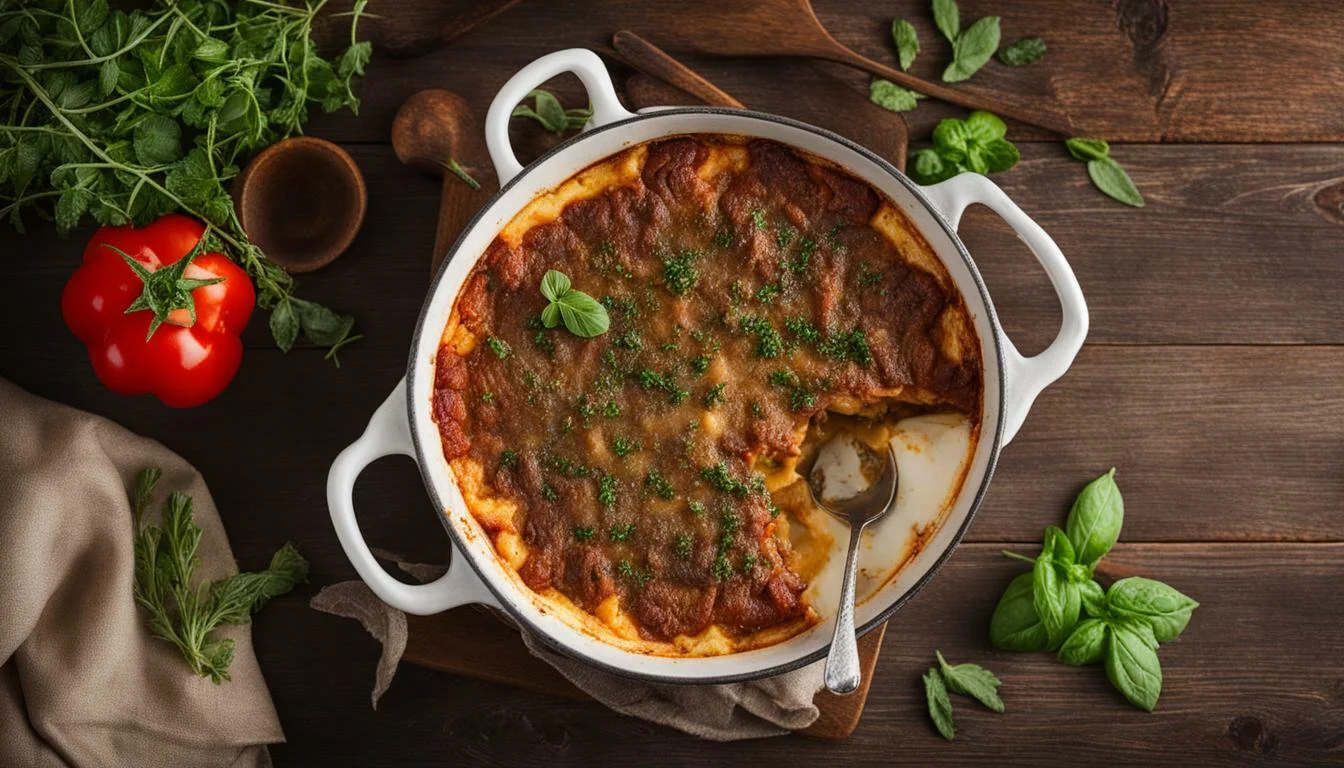Take Me to the Recipes
Imagine this: crystal-clear turquoise waters lapping at golden shores, ancient ruins whispering stories of the past, and vibrant cities bustling with life. But Cyprus isn’t just about picture-perfect scenery; it’s a culinary adventure waiting to tantalize your taste buds.
This sun-drenched island is a Mediterranean treasure trove, where flavors dance between Greek, Turkish, and Middle Eastern influences. Think succulent grilled meats, tangy dips, fresh seafood stews, and sweet treats that melt in your mouth. But beyond the delicious dishes, Cypriot cuisine is woven with rich history and tradition, offering a glimpse into the heart of the island’s soul.
Ready to embrace the warmth of the Mediterranean and savor the flavors of Cyprus? Join us on a journey through the island’s vibrant cuisine, uncovering hidden gems, exploring historical influences, and sharing mouthwatering recipes to recreate at home. Pack your appetite for adventure, because in Cyprus, every bite is a story waiting to be told.
Take Me to the Recipes
Cypriot Cuisine – Key Takeaways:
- Explore the diverse and delicious world of Cypriot Cuisine and recipes.
- Discover the rich culinary heritage of Cyprus and its traditional recipes.
- Try must-try Cypriot dishes for an authentic experience.
- Learn about famous Cypriot recipes, from mezedes to desserts.
- Embrace the Cypriot culinary spirit in your own kitchen with tips and techniques for authentic flavors.
Take Me to the Recipes
Where is Cyprus?

Cyprus is the third-largest and third-most populous island in the Mediterranean. It is located east of Greece, north of Egypt, south of Turkey, and west of Lebanon and Syria. Its capital and largest city is Nicosia.


Index to the Contents
- Take Me to the Recipes
- More Articles
- Interesting Facts About Cyprus
- Cyprus’s History and the Affect It Has Had on the Cuisine
- What impact has the Climate and Geography had on Cypriot Food?
- Understanding the Essence of Cypriot Cuisine
- The Importance of Food in Cypriot Culture
- Cypriot Culinary Traditions
- Traditional Dishes of Cyprus
- The National Dish of Cyprus
- Cypriot Ingredients
- How Healthy is Cypriot Food?
- Must-Try Cypriot Cuisine Dishes for an Authentic Experience
- Embracing the Cypriot Culinary Spirit in Your Kitchen
- Famous Cypriot Cuisine Recipes you can Try at Home
- Conclusion
- FAQ’s
You may also be interested in the following articles
- North and South American Cuisine – A Culinary Expedition
- European Cuisine: Savor the Continent’s Best Culinary Secrets!
- African Cuisine: Discover the Bold Flavors & Global Charm!
- Asian Cuisine Unlock its Secrets – Taste, Health & Global Influence!
- Oceania Cooking: A Culinary Journey Through the Pacific
Savor iconic Cypriot Recipes – Click on each tantalizing Image to open up the Recipe
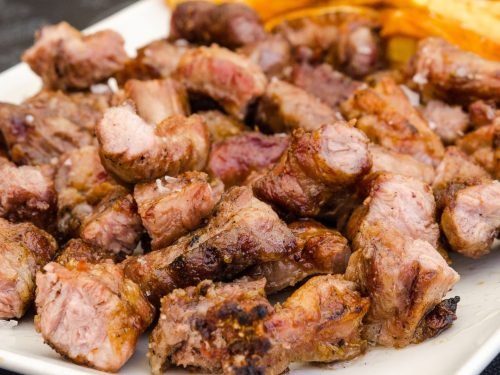
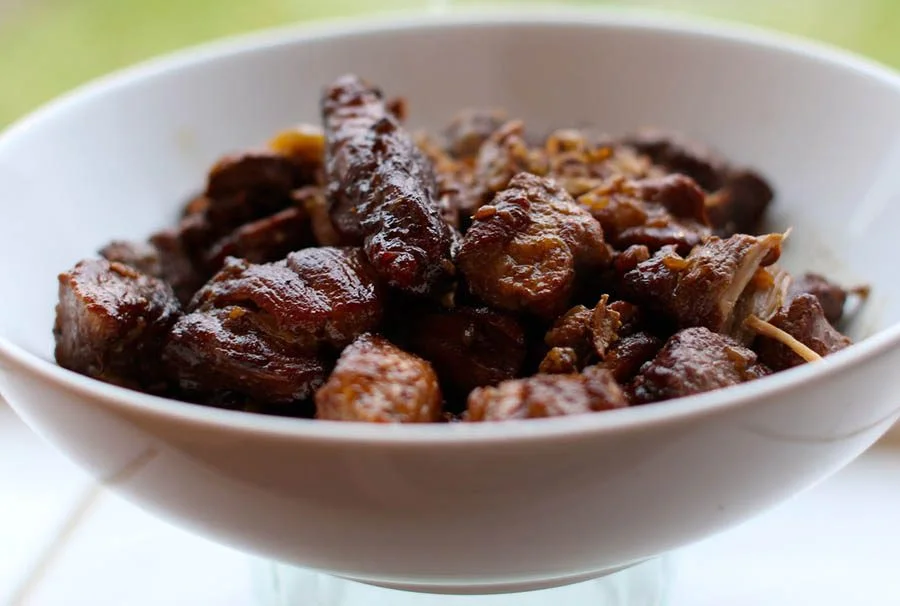


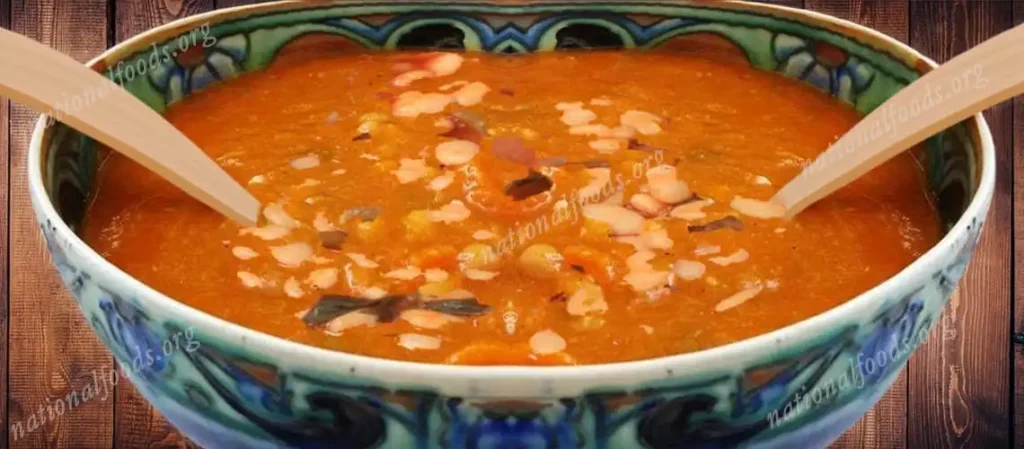



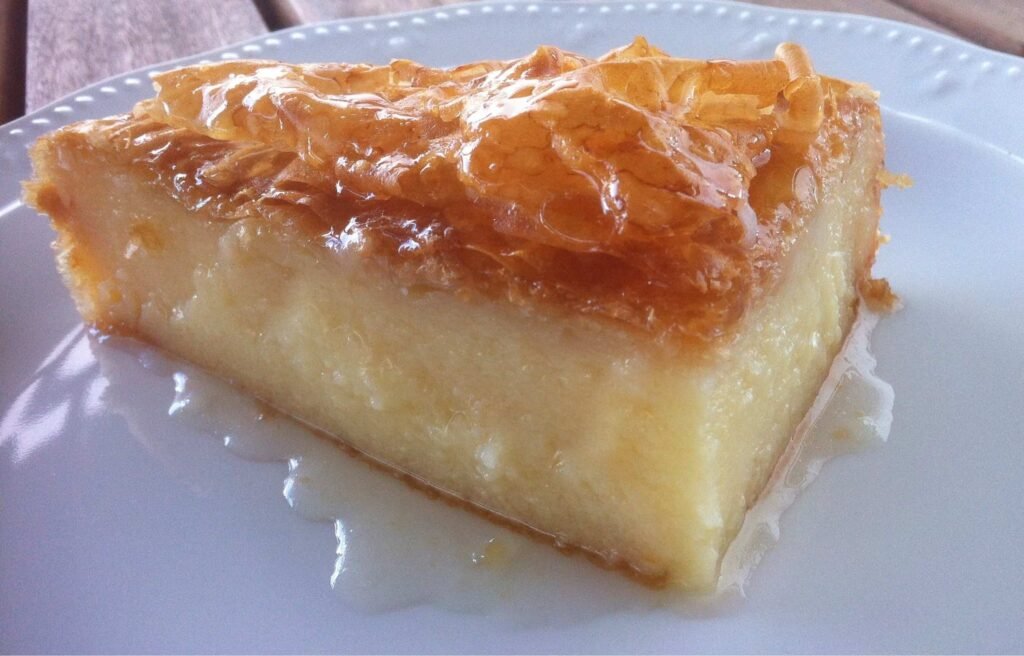


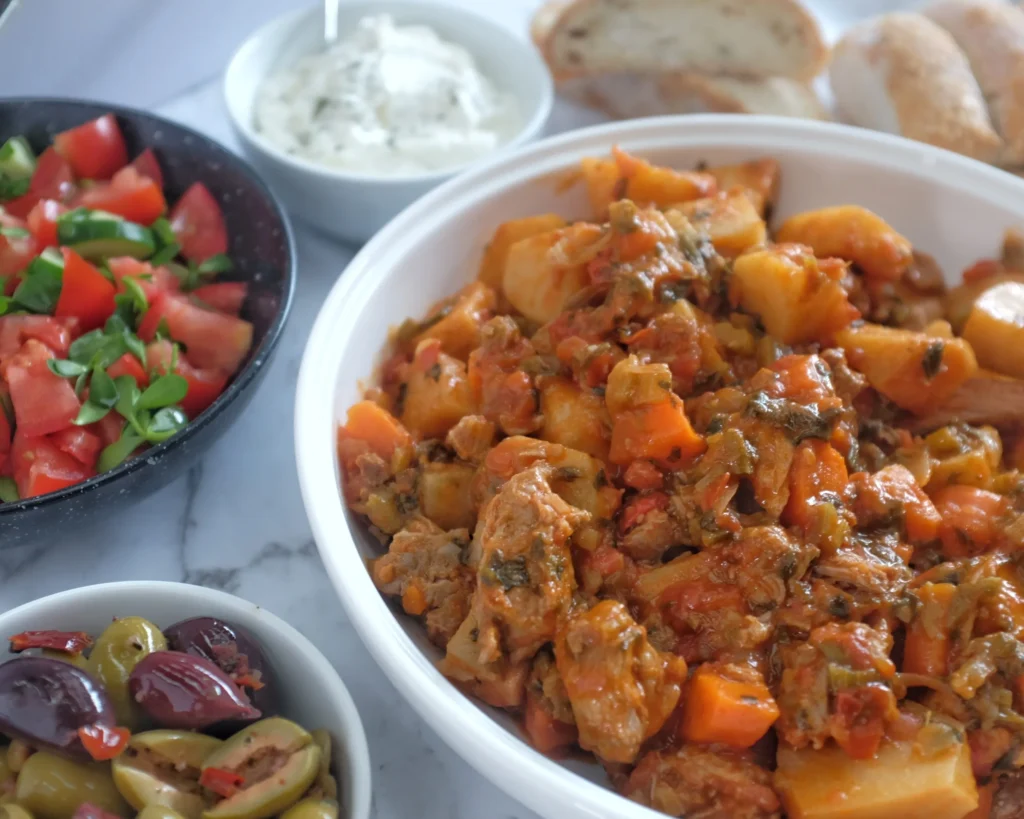


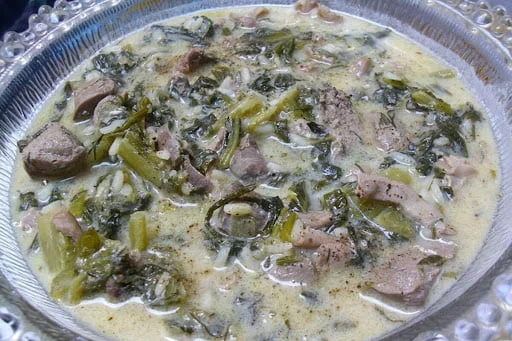
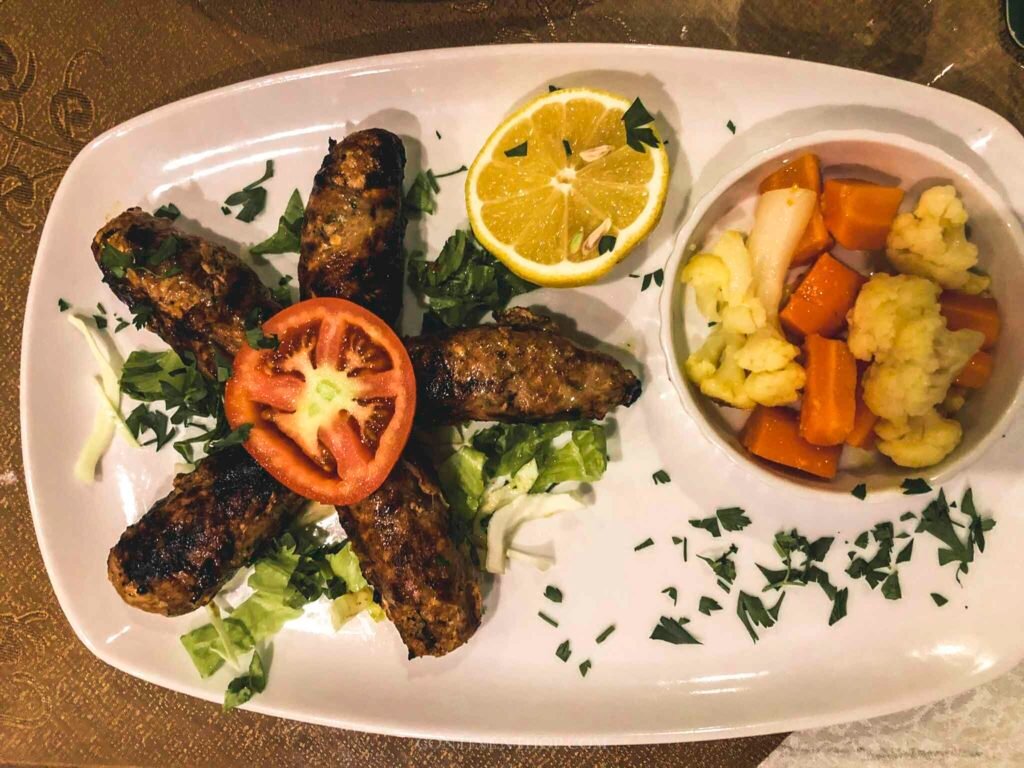

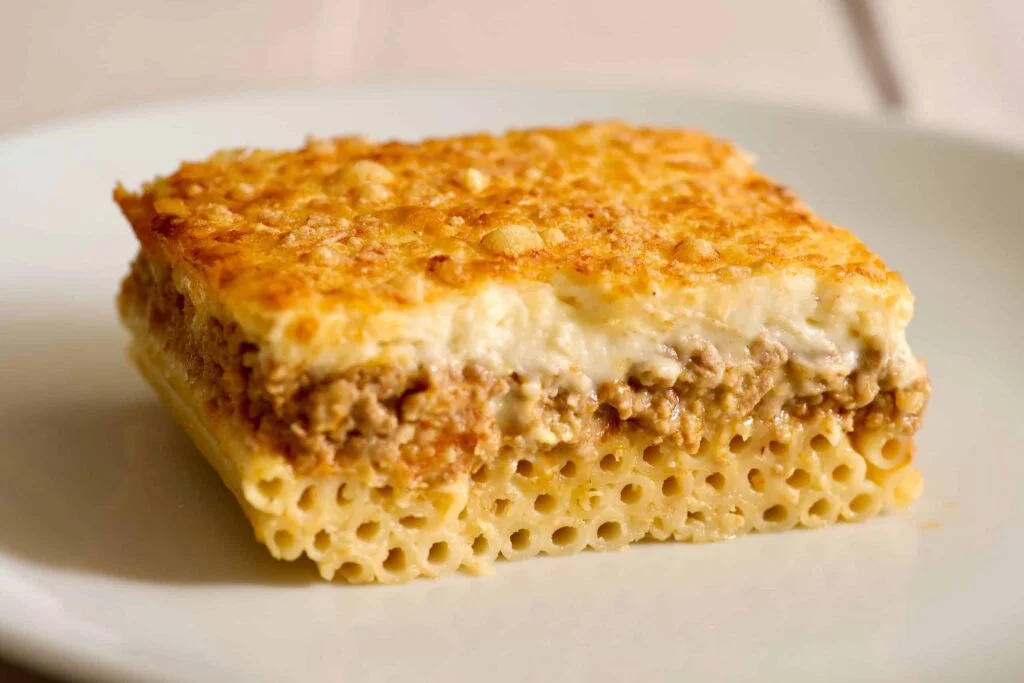
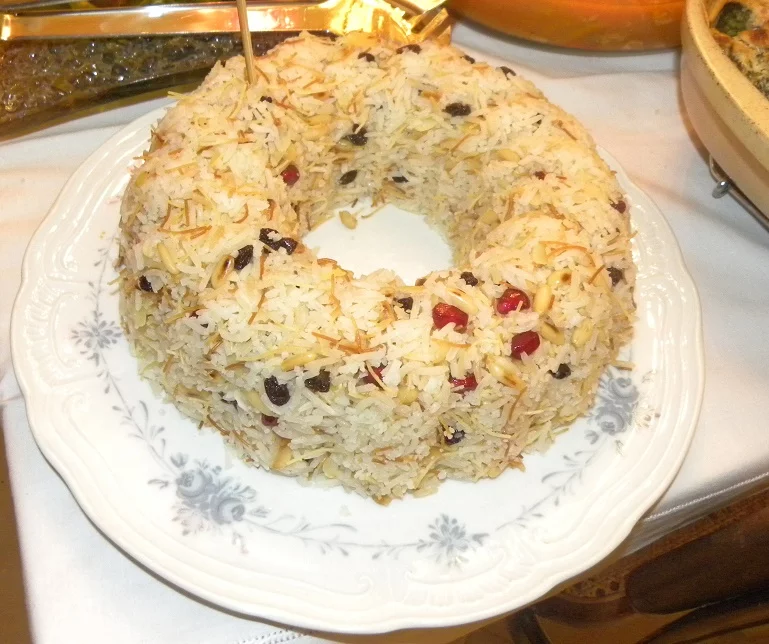
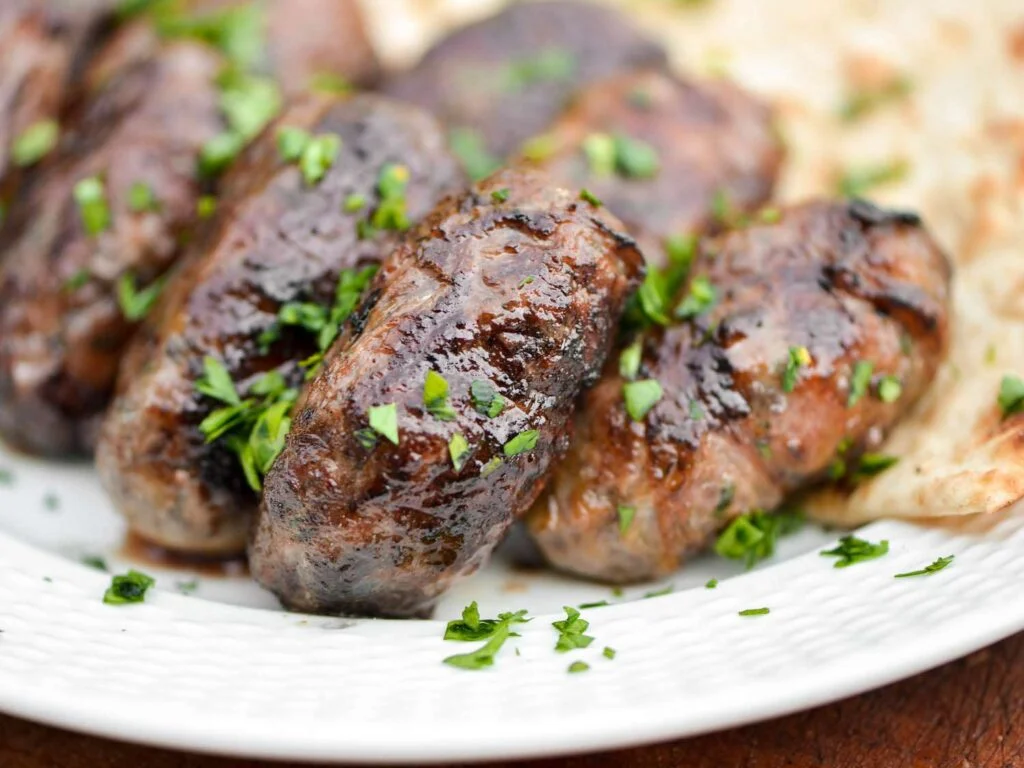

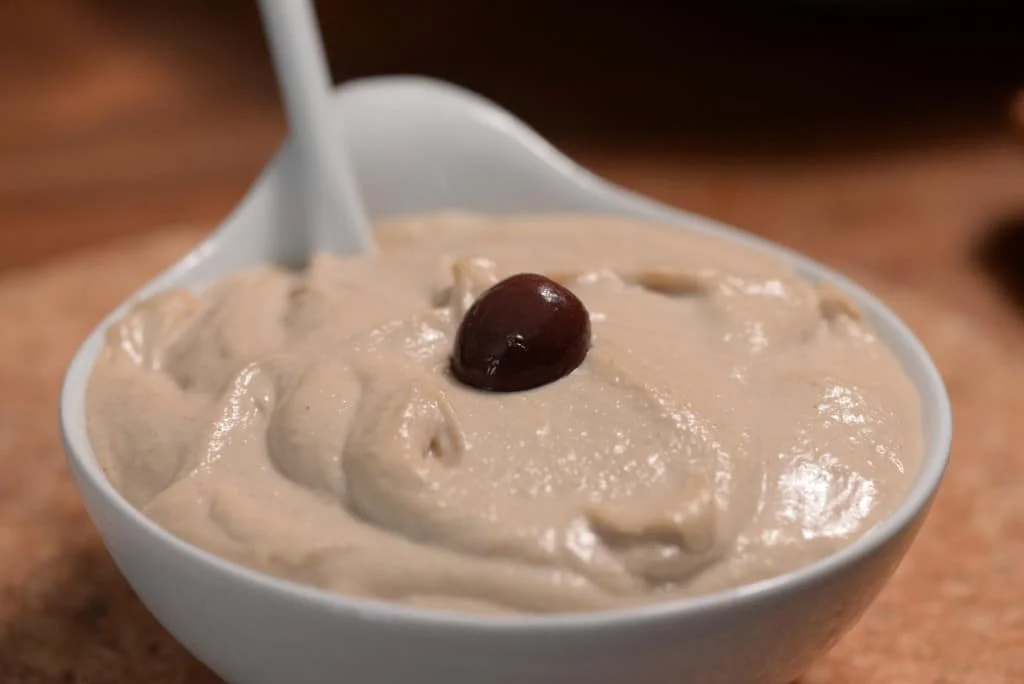

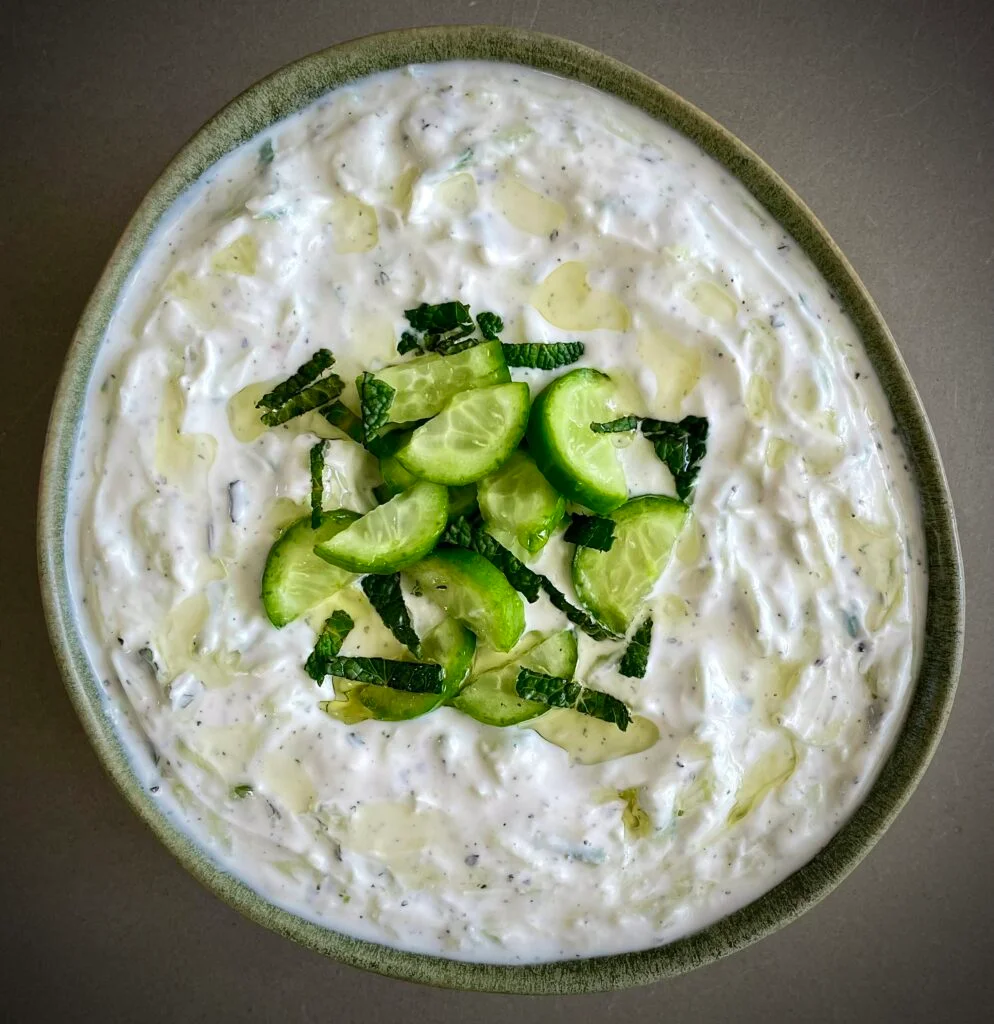
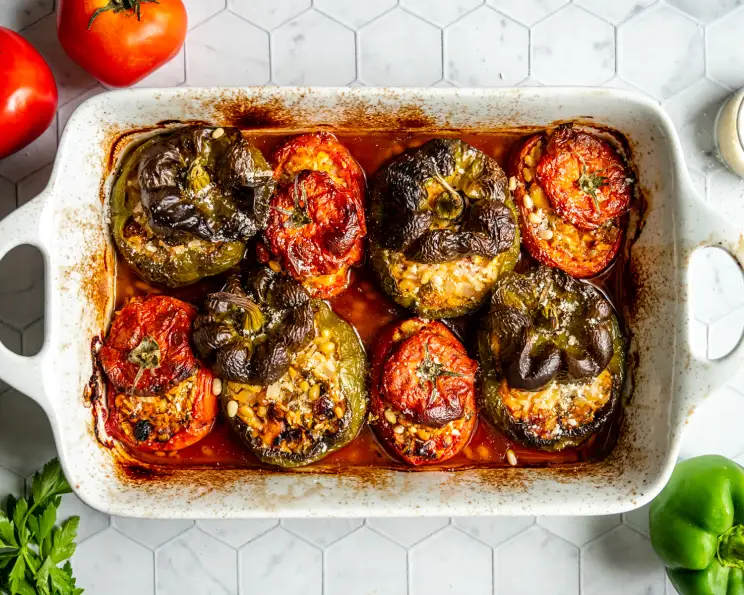
Interesting Facts About Cyprus
Cyprus: A Land Steeped in Winemaking History (but Hold the Huge Numbers!)

Calling all wine lovers! Did you know that Cyprus boasts a winemaking tradition stretching back a whopping 6,000 years? That’s right, while they may not be the biggest producers (ranking around 50th globally), they’re one of the oldest in the game!
This island nation is practically swimming in grapevines, and they produce a diverse range of delicious wines. One highlight is the Commandaria, a sweet, sun-dried grape wine with a rich history and unique flavor profile.
So, ditch the intimidating numbers and join me on a journey through the intriguing world of Cypriot wines. You might just discover your new favorite bottle!
Immerse yourself in history at Paphos, a UNESCO World Heritage Gem

Nestled on the sunny shores of Cyprus, Paphos isn’t just a charming town; it’s an open-air museum brimming with ancient treasures.
History buffs will be in paradise, with highlights like the Tombs of the Kings, a necropolis carved into the rock face, and the stunning Paphos Mosaics, vibrant floor art depicting mythological scenes. So, put on your explorer hat and step back in time at Paphos!
A Tale of Two Cities: Exploring Nicosia, the Last Divided Capital in Europe

Imagine a city split in two, mirroring the Cold War division of Europe. That’s Nicosia, Cyprus, the only remaining divided capital on the continent since the Berlin Wall fell. Since 1974, a UN-patrolled “Green Line” has physically separated the city, shaping two distinct halves.
Step south, and you’ll find a vibrant Greek Cypriot atmosphere with Christian traditions and influences. Cross the line, and you’ll enter the Turkish Cypriot north, marked by Muslim customs and a different cultural tapestry. Language, currency, and even the pace of life shift as you traverse this unique urban divide.
While the situation is sensitive for Cypriots, the city remains open to visitors with valid passports and visas. Crossing checkpoints grants you a glimpse into both sides, offering a rare chance to experience contrasting cultures within a single metropolis.
Sunshine Seeker’s Paradise: Soak Up 320 Days of Sunny Bliss in Cyprus

Craving a sunshine-soaked escape? Look no further than Cyprus, the Mediterranean gem boasting a legendary climate with an astounding 320 days of sunshine a year!
This island paradise basks in a subtropical climate, making it a year-round haven for Vitamin D enthusiasts. Eight glorious months are bathed in warm sunshine, and even winter whispers pleasant whispers, with average highs of 17-18°C in January and February.
So, ditch the winter blues and trade them for endless azure skies and sun-kissed beaches. Cyprus awaits with open arms, ready to warm your soul and recharge your energy reserves.
Dive into History: Exploring the Sunken Treasures of the Zenobia Wreck





Imagine a majestic ferry, embarking on its maiden voyage only to succumb to the depths just hours later. That’s the story of the Zenobia, a steel giant now resting in Larnaca Bay, Cyprus, and a magnet for adventurous divers.
This captivating shipwreck, sunk in the 1980s for unknown reasons, lies at a mesmerizing depth of 40 meters. As you descend, the enormity of the vessel unfolds, leaving a lasting impression. Explore its vast hull, teeming with schools of vibrant fish weaving between scattered, rusty trucks – remnants of its ill-fated journey.
The Zenobia isn’t just a shipwreck; it’s a treasure trove of history and marine life, attracting divers from around the world. But remember, Cyprus offers divers a smorgasbord of underwater gems! Explore diverse dive sites teeming with coral reefs, ancient amphoras, and vibrant marine life.
Feline Fiesta: Exploring the Fascinating Legacy of Cats in Cyprus

Stroll through any Cypriot city, and you’ll likely encounter a furry surprise: a multitude of cats roaming freely! This isn’t just a recent phenomenon; cats have been deeply woven into Cyprus’s history for over 2,000 years.
Back in the 4th century BC, a plague of snakes threatened the island. Desperate Cypriots fled their homes, leaving the reptiles to run rampant. Enter Saint Queen Helena, who had a purrfect solution: import 1,000 cats from Egypt! These feline heroes swiftly cleared the island of its slithering menace, earning them the eternal gratitude of the locals.
Legend has it that these “saviors” initially resided in the Saint Nicholas Monastery (now nicknamed the “Cat Monastery”), 10km from Limassol. Ever since, Cypriots have held cats in high regard, treating them with respect and affection.
But why choose Cyprus for your next vacation? Aside from the heartwarming cat culture, you’ll discover:
- Stunning beaches and crystal-clear waters: Perfect for swimming, sunbathing, and soaking up the Mediterranean sunshine.
- Rich history and ancient ruins: Explore archaeological sites, medieval castles, and charming villages.
- Delicious cuisine: Savor fresh seafood, mouthwatering meze platters, and local wines.
- Warm hospitality: Experience the friendly and welcoming nature of the Cypriot people.
So, why wait? Come experience the magic of Cyprus – where history purrs and feline friends await your arrival!
Cyprus’s History and the Affect It Has Had on the Cuisine
Cyprus, a Mediterranean island with a rich history, has seen a tapestry of civilizations that shaped not only its cultural heritage but also its distinctive culinary landscape. Let’s explore the different historical periods and their profound impact on the local cuisine:
Ancient Times (Pre-1000 BC)
Cyprus boasts an ancient history dating back to the Neolithic era. During this time, inhabitants relied on agriculture, cultivating grains, olives, and grapes. The foundation for the island’s staple ingredients was laid, setting the stage for the Mediterranean diet.
Assyrian and Egyptian Influence (1000-500 BC)

Cyprus fell under Assyrian and Egyptian influence, bringing new flavors such as spices and herbs to the culinary repertoire. Trade routes flourished, introducing ingredients like coriander, cumin, and garlic, which found their way into Cypriot kitchens.
Persian Rule (545-333 BC)
The Persian era brought a fusion of culinary traditions, emphasizing the use of nuts, fruits, and honey. Persian influences can be seen in the Cypriot preference for incorporating sweet and savory elements into dishes, a characteristic that persists in modern cuisine.
Hellenistic Period (333-30 BC)
Under Hellenistic influence, Cyprus became a part of the broader Greek world. This era significantly impacted the island’s culinary scene, with the integration of Greek staples like olives, olive oil, and an array of herbs. Grilled meats and seafood gained prominence during this time.
Roman Rule (30 BC – 330 AD)
Roman domination left a lasting impact on Cypriot cuisine. The introduction of new cooking techniques, such as baking and stewing, contributed to the evolution of local dishes. The Romans also brought wine culture, solidifying Cyprus’s reputation as a wine-producing region.
Byzantine Period (330-1191 AD)
With the Byzantine period came a preservation of traditional Greek and Roman culinary elements. The use of dairy products and aromatic herbs became more pronounced, laying the foundation for Cypriot meze, a collection of small dishes representing the island’s gastronomic diversity.
Crusader Rule (1191-1489 AD)
During the Crusader era, trade flourished, and spices from the East, including cinnamon and cloves, found their way into Cypriot kitchens. This period marked a further blending of flavors, influencing the island’s unique spice palette.
Ottoman Rule (1571-1878 AD)
Ottoman rule profoundly shaped Cypriot cuisine. New ingredients like kebabs, baklava, and mousakka were introduced, reflecting the Turkish influence. The use of yogurt became widespread, contributing to the creamy textures found in many Cypriot dishes.
British Colonial Period (1878-1960 AD)

The British colonial period introduced elements of Anglo-Saxon cuisine, with an emphasis on roasted meats and pies. Potatoes became a staple, finding their way into classic dishes like moussaka and kleftiko.
Post-Independence (1960 AD – 1974)
Post-independence, Cypriot cuisine retained its eclectic nature. Globalization brought international influences, and the island embraced a culinary fusion while preserving its rich traditional heritage. Local markets thrive, offering fresh produce, olive oil, and traditional cheeses, maintaining the essence of Cypriot cooking.
In conclusion, Cyprus’s culinary journey reflects the island’s intricate history, blending diverse cultural influences into a harmonious tapestry of flavors that make Cypriot cuisine a delightful exploration for food enthusiasts.
Post Turkish Invasion (1974 – Present Times)
In 1974, Turkey invaded Cyprus in response to a coup led by elements within the Greek military seeking to unite Cyprus with Greece. The invasion led to the de facto partition of the island, with the creation of the internationally unrecognized Turkish Republic of Northern Cyprus in the northern part of the island.
The southern part, the Republic of Cyprus, remains internationally recognized as the legitimate government of the entire island. The events of 1974 and their aftermath have had a lasting impact on the political, social, and cultural landscape of Cyprus.
The invasion and the subsequent Green Line have undoubtedly influenced the culinary dynamics of the island.
Despite the political division, efforts have been made to promote unity and collaboration through food. Various initiatives, such as cultural exchange programs and joint culinary events, aim to bridge the gap and foster a sense of shared heritage.
While political divisions persist, the people of Cyprus continue to find common ground through their shared love for traditional dishes, and culinary diplomacy acts as a reminder of the cultural connections that transcend political borders.
What impact has the Climate and Geography had on Cypriot Food?

Cypriot cuisine is a delightful fusion of flavors shaped by the island’s Mediterranean climate, geography, and rich history. Let’s explore how these factors have influenced the delectable dishes enjoyed by both Greek Cypriots and Turkish Cypriots:
Cyprus has a Mediterranean Climate
The warm Mediterranean climate of Cyprus plays a significant role in shaping its cuisine. The abundance of sunshine allows for the cultivation of flavorful fruits, vegetables, and herbs.
Fresh vegetables such as courgettes (zucchini), olives, okra, green beans, artichokes, carrots, tomatoes, cucumbers, lettuce, and grape leaves are staples in Cypriot cooking.
The intense sunlight also contributes to the ripening of fruits like oranges, grapes, and figs, which find their way into various dishes.
Cypriot Geography and History
Cyprus’s strategic location in the eastern Mediterranean has made it a melting pot of culinary influences.
Reflecting the island’s history, Cypriot cuisine is a harmonious blend of Greek and Turkish culinary traditions. Local twists have been added to well-known dishes.
Neighboring countries—such as those in the Levant and Anatolia—have left their mark on Cypriot cooking. Arabic and Middle Eastern influences are evident.
Remnants of French, Italian, and Anglo-Saxon culinary elements also exist due to the island’s historical occupations by the Luisignan Franks, Venetians, and British.
Modern Western cuisine, including fast food, has gradually made its way into the daily diet on the island.
References
Understanding the Essence of Cypriot Cuisine
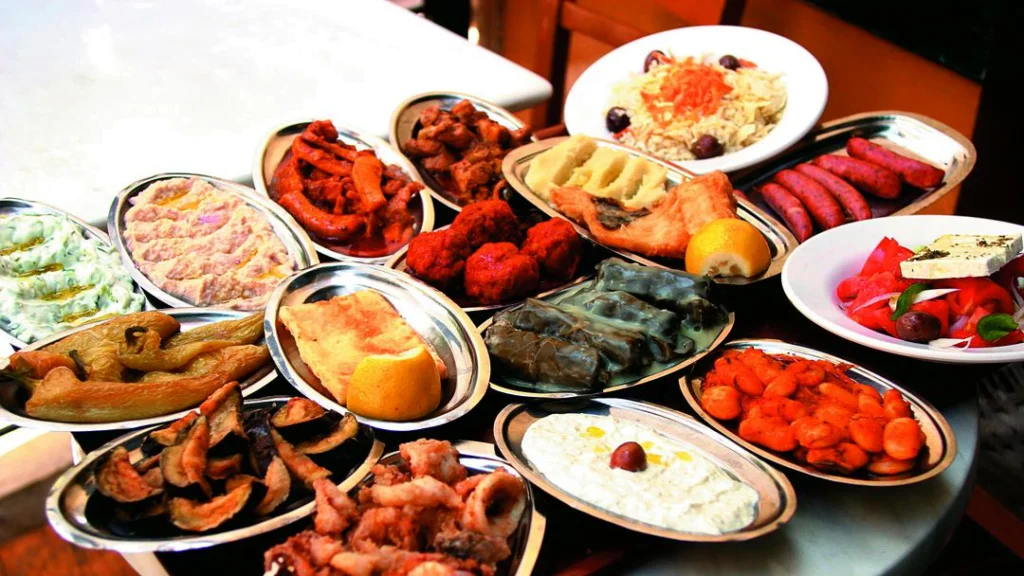
The island of Cyprus, bathed in the warmth of the Mediterranean sun and kissed by its azure waters, offers a cuisine that’s as rich and varied as its millennia-old history. To understand Cypriot cuisine is to embrace its unique blend of indigenous traditions and the influences of its many occupiers and neighbors.
Central to Cypriot food is the concept of ‘meze’, a parade of small dishes, often spanning over 20 courses, that captures the island’s culinary depth. From savory ‘halloumi’ cheese, often grilled or fried, to delicate ‘loukaniko’ sausages spiced with coriander and wine, meze is a celebration of local flavors and communal dining.
Cyprus’s geographic location made it a strategic jewel, coveted by empires like the Venetians, Ottomans, and the British. Each brought culinary influences, further enriching the island’s gastronomic fabric. The Turkish impact is evident in dishes like ‘moussaka’, a luscious layering of eggplant, meat, and béchamel sauce, while British colonial rule introduced goods like tea.
The island’s bounteous orchards and vineyards give Cypriot cuisine its fresh ingredients. Olive oil, citrus fruits, and indigenous grape varieties play significant roles. The Commandaria wine, produced in Cyprus, is among the world’s oldest named wines, reflecting the island’s deep-rooted viticultural traditions.
Moreover, the Cypriot love for herbs and spices, such as mint, oregano, and cinnamon, adds distinctive layers of flavor to dishes. ‘Souvla’ and ‘souvlaki’, skewered and grilled meats, embody the Cypriots’ penchant for char-grilled foods, drawing from ancient Hellenic rituals.
In essence, Cypriot cuisine is a mirror to its vibrant history and Mediterranean soul. It’s a confluence of East and West, a symphony of flavors, and, most importantly, an ode to the island’s spirit of resilience and hospitality. Every bite evokes tales of ancient kingdoms, sea voyages, and timeless Cypriot celebrations.
The Importance of Food in Cypriot Culture

Food plays a pivotal role in Cypriot culture, far exceeding its basic function of nourishment. It’s a powerful force that binds communities, celebrates traditions, and reflects the rich history and identity of the island. Here’s a glimpse into why food holds such significance:
Shared Meals, Shared Lives
Cypriots cherish the experience of communal dining, where meals become social gatherings. Family and friends gather around tables laden with dishes, fostering connection, conversation, and a sense of belonging.
Sharing food signifies warmth, hospitality, and generosity, strengthening social bonds.
A Culinary Tapestry of History
Cypriot cuisine reflects the island’s multicultural past, influenced by Greeks, Romans, Persians, Arabs, and Ottomans. Each dish whispers stories of cultural interaction, adaptation, and innovation. From fragrant stews to succulent kebabs, every bite embodies a journey through time.
Honoring Traditions
Food plays a central role in religious festivals and celebrations. Special dishes are prepared for each occasion, passed down through generations, connecting Cypriots to their heritage and strengthening cultural identity.
From Easter lamb roast to Christmas sweets, each bite carries symbolic meaning and cultural significance.
Local Bounty, Local Pride
Cypriots take immense pride in the fresh, seasonal ingredients grown and produced on the island. From citrus fruits and olives to succulent seafood and locally raised lamb, local produce forms the foundation of traditional cuisine.
Supporting local farmers and enjoying the fruits of their labor strengthens community spirit and appreciation for the land.
A Bridge Across Divides
Despite the complex political situation, food remains a unifying force across the island. Sharing traditional dishes and celebrating culinary heritage transcends boundaries, fostering dialogue and understanding between different communities.
Food in Cyprus is more than just sustenance; it’s a cultural cornerstone, a thread weaving together history, tradition, and community. It’s a language spoken through flavors, aromas, and shared experiences, offering a unique window into the heart and soul of Cypriot life.
Cypriot Culinary Traditions
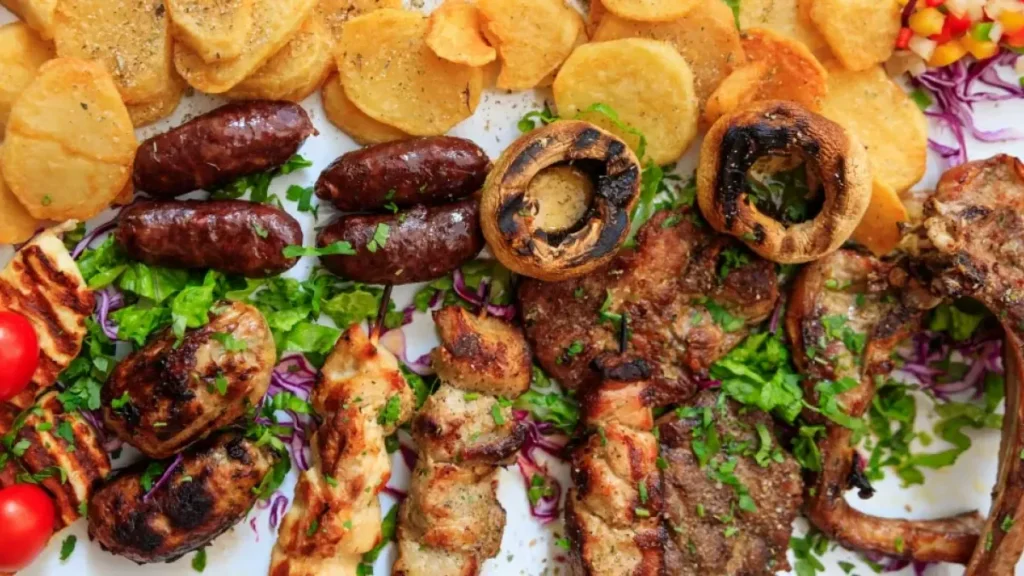
The soul of Cyprus, an island steeped in history and diverse cultures, shines brightly in its culinary traditions. Central to this is the notion of sharing and community, evident in the much-loved ‘meze’. A sequence of small dishes, ‘meze’ captures the essence of Cypriot food, offering everything from marinated olives to grilled meats, each dish telling a story of its own.
Breakfast in Cyprus often consists of ‘halloumi’, the semi-hard cheese that has become synonymous with Cypriot identity. Paired with fresh bread, olives, and tomatoes, it’s a meal that resonates with simplicity and freshness. The midday might bring ‘kleftiko’, slow-cooked lamb marinated in herbs, reminiscent of ancient pastoral traditions.
Another stalwart is ‘souvlaki’, skewered and grilled pieces of meat, evoking age-old Hellenic rituals of cooking meat over open flames. On special occasions, ‘afelia’, pork stewed in red wine and coriander seeds, graces the Cypriot table, embodying the island’s love for aromatic and hearty dishes.
Sweet treats like ‘loukoumades’, honey-soaked doughnuts sprinkled with cinnamon, offer glimpses of both ancient Greek traditions and later Middle Eastern influences.
Traditional Dishes of Cyprus

Here are some traditional dishes of Cyprus:
Souvlaki
Skewers of grilled meat, typically pork, chicken, or lamb, marinated in herbs and spices. Often served with pita bread, salad, and tzatziki sauce.
Halloumi
A semi-hard, brined cheese made from sheep and goat’s milk. Can be grilled, fried, or eaten fresh.
Moussaka
A layered dish of ground meat, eggplant, potatoes, and béchamel sauce.
Sheftalia
A sausage made from minced pork, lamb, and spices, wrapped in caul fat and grilled.
Kleftik
Slow-cooked lamb or goat, traditionally wrapped in foil and cooked in an oven.
Meze
A selection of small plates, typically served as appetizers. Can include dips, salads, dolmades, olives, and grilled meats and vegetables.
Loukoumades:
Deep-fried dough balls, drizzled with syrup and sprinkled with cinnamon or nuts.
Galatopoureko
A semolina custard pie, usually served with cinnamon and sugar.
Baklava
A filo pastry dessert filled with chopped nuts and soaked in syrup.
Commandaria
A sweet dessert wine made from sun-dried grapes.
These are just a few of the many delicious dishes that make up Cypriot cuisine. If you ever have the chance to visit Cyprus, be sure to try some of these traditional dishes!
The National Dish of Cyprus

Craving a hearty, soul-warming experience? Look no further than Fasolada, the beloved national dish of Cyprus. This flavorful bean and vegetable soup isn’t just a culinary classic; it’s a cultural icon, simmering with history and tradition.
Imagine tender white beans mingling with fresh vegetables, all bathed in a generous drizzle of Cypriot olive oil. Each spoonful bursts with the comforting flavors of aromatic herbs and spices, transporting you to the heart of Cypriot cuisine.
More than just delicious:
- Rooted in History: Fasolada’s origins stretch back centuries, reflecting the island’s diverse influences. It’s a humble dish made with simple ingredients, showcasing the Cypriot appreciation for fresh, local produce.
- Fueling Celebrations: This versatile soup graces tables throughout the year, from comforting winter meals to festive gatherings. It’s a symbol of community and shared experiences, bringing people together over warm bowls.
- Aromatic Adventure: Each region adds its unique twist, using different spices and vegetables. Explore variations with okra, tomatoes, or even seafood, discovering the vibrant tapestry of Cypriot flavors.
Ready to try Fasolada? Find authentic recipes online or explore Cypriot restaurants to savor this culinary gem. It’s more than just a soup; it’s a warm hug on a plate, waiting to embrace your taste buds and immerse you in the heart of Cypriot culture.
Cypriot Ingredients: The Flavors of Cyprus
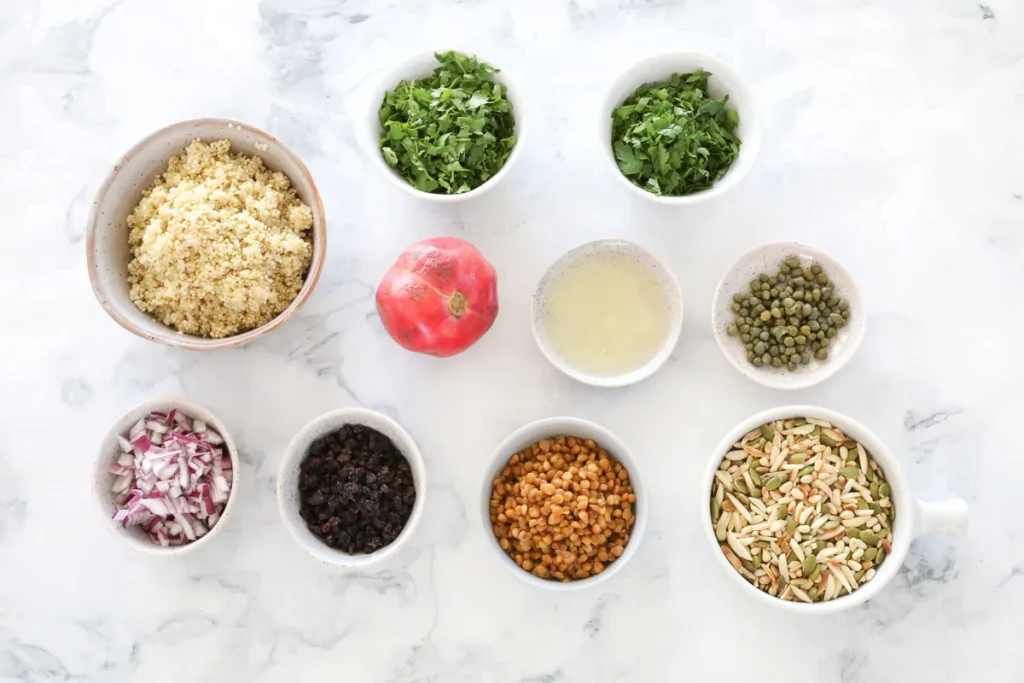
The flavors of Cyprus are a reflection of its sun-kissed landscapes, azure coastlines, and fertile plains. Key to Cypriot cuisine is the olive, producing oils that form the base of many dishes, lending them richness and depth. The island’s orchards offer citrus fruits like lemons and oranges, imparting dishes with a refreshing tang.
Another cornerstone is the ‘halloumi’ cheese, made from a mixture of goat’s and sheep’s milk, celebrated for its versatility. Grilled, fried, or fresh, it’s a true Cypriot delight.
Herbs like mint, parsley, and oregano grow abundantly, infusing dishes with aromatic nuances. Cumin and coriander, brought over during Ottoman rule, now play pivotal roles in flavoring meat dishes and stews.
Cyprus’s favorable climate ensures a steady supply of fresh vegetables, from artichokes to zucchinis. Grains, primarily wheat and barley, have ancient roots in the island’s culinary history, vital for bread-making and dishes like ‘koupes’.
But it’s perhaps the island’s wines, especially the sweet Commandaria, that capture the essence of Cypriot terroir. This age-old wine, with its deep amber hue and rich taste, is a testament to Cyprus’s enduring love affair with the vine.
Together, these ingredients create a palette from which the vibrant canvas of Cypriot cuisine is painted, each flavor a chapter in the island’s culinary saga.
How Healthy is Cypriot Food?

Cyprus, the sun-kissed island in the Mediterranean, boasts more than stunning beaches and ancient ruins. Its cuisine, a delicious blend of Greek, Turkish, and Middle Eastern influences, tempts travelers with its vibrant flavors. But is Cypriot food a recipe for health? Let’s delve into the nutritional bounty (and potential pitfalls) of this island feast.
Mediterranean Marvels
- Fresh and Local: Cypriot cuisine shines with seasonal ingredients, grown under the Mediterranean sun. Think juicy tomatoes, flavorful olives, and fresh seafood, packed with vitamins and minerals.
- Olive Oil Powerhouse: Extra virgin olive oil, a staple in Cypriot cooking, is a heart-healthy hero. Rich in monounsaturated fats and antioxidants, it protects your heart and promotes healthy aging.
- Legumes Galore: Lentils, chickpeas, and beans are common features, providing a nutritious punch of protein and fiber, keeping you feeling full and satisfied.
Balancing the Indulgences
- Meat and Cheese Indulgence: Cypriots love their grilled meats and creamy cheeses, like halloumi. While delicious, moderation is key to maintain a healthy balance. Opt for leaner cuts and smaller portions to manage saturated fat intake.
- Sweet Treats Aplenty: From baklava to loukoumades, Cypriot desserts are undeniably tempting. Enjoy them in moderation, and consider healthier alternatives like fresh fruit with yoghurt and honey.
- Salt with Caution: Be mindful of salt content, especially in processed foods and cured meats. Opt for fresh herbs and spices to add flavor naturally.
Overall Impact
Cypriot cuisine, when enjoyed in moderation and with an emphasis on fresh, local ingredients, can be a healthy and delicious part of your Mediterranean diet. Remember, portion control, mindful choices, and a balanced approach are key to unlocking the full health potential of this culinary journey.
So, is Cypriot food healthy?
The answer lies in your choices. Explore the island’s bounty of fresh produce, embrace the olive oil magic, and indulge in treats wisely. Let Cypriot cuisine be a delicious chapter in your healthy lifestyle story!
Must-Try Cypriot Cuisine Dishes for an Authentic Experience

Get ready to indulge in some of the most flavorful and authentic dishes Cyprus has to offer. These traditional Cypriot dishes are a must-try for any food enthusiast looking to experience the true taste of Cyprus.
- Moussaka: Made with layers of potatoes, eggplants, and ground beef, this savory dish is topped with béchamel sauce and baked until golden brown.
- Kleftiko: This hearty and tender lamb dish is slow-cooked in parchment paper with potatoes, onions, and tomatoes, and seasoned with garlic and oregano.
- Souvlaki: Grilled skewers of marinated chicken or pork, served with pita bread, fresh tomatoes, onions, and tzatziki sauce.
- Halloumi: A delicious semi-hard cheese made from sheep’s and goat’s milk, grilled or fried until crispy and served with fresh lemon juice.
- Sheftalia: A traditional Cypriot sausage made from a combination of pork, onions, parsley, and spices, wrapped in caul fat and grilled to perfection.
These popular Cypriot meals are full of flavor and sure to satisfy any appetite. Authentic Cypriot cooking is all about using fresh ingredients and traditional techniques. Using these you can create mouth-watering flavor filled dishes. So why not give these traditional Cypriot dishes a try and experience the true taste of Cyprus?
Embracing the Cypriot Culinary Spirit in Your Kitchen

Now that we’ve explored the delicious world of Cypriot cuisine and recipes, it’s time to bring that flavorful spirit into your own kitchen. Here are some tips to help you recreate the authentic taste of Cypriot food:
- Choose fresh ingredients: The key to any great dish is starting with fresh, high-quality ingredients. Whether it’s juicy tomatoes, tender lamb, or flavorful herbs, seek out the best ingredients you can find to truly capture the essence of Cypriot food.
- Experiment with spices: Cypriot cuisine often uses a blend of spices that create a unique flavor profile. Try using cumin, coriander, oregano, and cinnamon to give your dishes that distinctive Cypriot taste.
- Master traditional cooking techniques: Cypriot cuisine uses various cooking techniques, from grilling to baking. Learn how to properly grill meats or make phyllo dough to elevate your cooking skills and impress your guests.
- Don’t forget the mezedes: Mezedes are a staple of Cypriot cuisine and offer a great way to share a variety of flavors with friends and family. Try making your own dolmades or tzatziki to serve as appetizers or small plates.
By following these tips, you can easily embrace the Cypriot culinary spirit in your own kitchen and enjoy the delicious and authentic taste of Cypriot food.
Famous Cypriot Cuisine Recipes you can Try at Home
Cypriot cuisine is a rich tapestry of flavors that reflects the island’s unique history and cultural influences. Each generation passes the recipes to the next and continue to delight food lovers around the world.
Cypriot Food – Fasolada

Exploring Cypriot Flavors: Fasolada
History and Background:
Originating from the sun-kissed island of Cyprus, Fasolada is a traditional bean and vegetable stew that embodies the Mediterranean spirit. Cypriot cuisine, influenced by various cultures over centuries, showcases simplicity, freshness, and a harmonious blend of ingredients.
Fasolada, with its hearty combination of beans, tomatoes, and herbs, reflects the island’s agricultural richness and culinary heritage.
Cypriot Food – Fasolada Ingredients:
- 1 cup dried white beans, soaked overnight
- 2 tablespoons olive oil
- 1 large onion, finely chopped
- 2 carrots, diced
- 2 celery stalks, chopped
- 3 cloves garlic, minced
- 1 can (14 oz) diced tomatoes
- 1 tablespoon tomato paste
- 1 teaspoon dried oregano
- 1 teaspoon dried thyme
- Salt and pepper to taste
- 4 cups vegetable broth
- Fresh parsley for garnish
Cypriot Food – Fasolada Recipe
Prepare the Beans
- Rinse the soaked white beans and set aside.
Sauté Aromatics
- In a large pot, heat olive oil over medium heat.
- Add chopped onions, carrots, and celery. Sauté until softened.
- Stir in minced garlic and cook until fragrant.
Build the Base
- Add the diced tomatoes, tomato paste, oregano, thyme, salt, and pepper. Mix well.
- Pour in the soaked white beans and vegetable broth. Stir to combine.
Simmer to Perfection
- Bring the mixture to a boil, then reduce heat to low.
- Cover the pot and simmer for 1.5 to 2 hours or until the beans are tender.
Garnish and Serve
- Check seasoning and adjust if necessary.
- Ladle the Fasolada into bowls, garnish with fresh parsley, and serve hot.
Serving Size and Nutritional Information:
- Serves: 4-6 people
- Cooking Time: 1.5 to 2 hours
- Calories: Approximately 250 per serving
Enjoy this heartwarming Fasolada, a taste of Cypriot tradition that brings the flavors of the Mediterranean to your table.
Cypriot Food – Meze

The Heart of Cyprus: Exploring the Culinary Tapestry of Meze
Welcome to my culinary corner, where today we’re diving into the vibrant world of Cypriot cuisine with a focus on the beloved tradition of Meze. Originating from the sun-soaked island of Cyprus, Meze is a delightful assortment of small, shareable dishes that embody the essence of Mediterranean hospitality.
These tantalizing bites reflect the rich history and diverse cultural influences that make Cypriot cuisine truly special. Join me as we bring the flavors of Meze into your home, creating a spread that celebrates the joy of communal dining!
Cypriot Food – Meze Ingredients
- 1 cup hummus
- 1 cup tzatziki sauce
- 1 cup baba ganoush
- 1 cup olives (mixed variety)
- 1 cup feta cheese, cubed
- 1 cup halloumi cheese, sliced
- 1 cup grape leaves, stuffed
- 1 cup cherry tomatoes, halved
- 1 cup cucumber, sliced
- 1 cup roasted red peppers, sliced
- 1 cup grilled eggplant, sliced
- 1 cup pita bread, cut into triangles
- 1/4 cup extra virgin olive oil
- 1 tablespoon dried oregano
- Salt and pepper to taste
- Lemon wedges for serving
Cypriot Food – Meze Recipe
1. Hummus, Tzatziki, and Baba Ganoush Trio:
a. Arrange small bowls on a platter and fill each with hummus, tzatziki, and baba ganoush. b. Drizzle a little extra virgin olive oil over each dip and sprinkle with dried oregano.
2. Cheese Delights:
a. Create a cheese section on the platter, arranging feta and halloumi slices together. b. Sprinkle the feta with oregano, and grill the halloumi until golden on both sides.
3. Olive and Stuffed Grape Leaves Ensemble:
a. Scatter mixed olives and stuffed grape leaves around the platter, creating a vibrant display.
4. Fresh Vegetables:
a. Arrange cherry tomatoes, cucumber slices, roasted red peppers, and grilled eggplant on the platter for freshness and color.
5. Pita Bread Perfection:
a. Toast pita triangles until lightly crispy, then arrange them on the platter for dipping.
6. Final Touches:
a. Drizzle extra virgin olive oil over the entire Meze spread. b. Add salt and pepper to taste. c. Garnish with lemon wedges for an extra burst of flavor.
Serving Information:
- Serves: 4-6 people
- Cooking Time: 20 minutes (if grilling cheese and toasting pita)
- Estimated Calories:
- Hummus: 50 calories per 2 tablespoons
- Tzatziki: 30 calories per 2 tablespoons
- Baba Ganoush: 40 calories per 2 tablespoons
- Olives: 25 calories per 1/4 cup
- Feta Cheese: 70 calories per 1 ounce
- Halloumi Cheese: 80 calories per 1 ounce
- Grape Leaves: 25 calories each
- Cherry Tomatoes: 15 calories per 1/2 cup
- Cucumber: 10 calories per 1/2 cup
- Roasted Red Peppers: 20 calories per 1/2 cup
- Grilled Eggplant: 30 calories per 1/2 cup
- Pita Bread: 80 calories per piece
There you have it – a delightful Meze platter that captures the spirit of Cyprus. Share these delectable bites with friends and family and savor the joy of a Cypriot feast right in your home! Stay tuned for more culinary adventures from my kitchen to yours!
Cypriot Food – Galatopoureko

A Sweet Journey to Cyprus: The Tale of Galatopoureko
Step into my kitchen, where today we’re exploring the sweet side of Cypriot cuisine with the delightful Galatopoureko. Originating from the enchanting island of Cyprus, this dessert is a cherished part of local celebrations and family gatherings.
With layers of flaky pastry and a luscious custard filling, Galatopoureko is a true testament to the rich culinary heritage of this Mediterranean gem. Join me as we embark on a journey to create this sweet masterpiece in the comfort of your own home!
Cypriot Food – Galatopoureko Ingredients
- 1 package phyllo dough (about 16 sheets)
- 1 cup unsalted butter, melted
- 4 cups whole milk
- 1 cup granulated sugar
- 1 cup semolina
- 4 large eggs
- 1 teaspoon vanilla extract
- 1 teaspoon lemon zest
- 1 cup water
- 1 cup honey
- 1 cinnamon stick
Cypriot Food – Galatopoureko Recipe
1. Preparing the Custard Filling:
a. In a saucepan, heat the whole milk over medium heat until it simmers. b. In a separate bowl, whisk together sugar, semolina, eggs, vanilla extract, and lemon zest. c. Gradually pour the hot milk into the egg mixture, whisking continuously. d. Return the mixture to the saucepan and cook over low heat, stirring constantly until it thickens. Remove from heat and let it cool.
2. Assembling the Galatopoureko:
a. Preheat your oven to 350°F (175°C). b. Brush a baking dish with melted butter. c. Place a sheet of phyllo dough in the dish, brush with melted butter, and repeat with 8 sheets. d. Pour the cooled custard over the phyllo layers. e. Top the custard with another 8 sheets of phyllo, brushing each layer with melted butter.
3. Baking and Cutting:
a. Bake in the preheated oven for 45-50 minutes or until golden brown. b. While baking, prepare the syrup: In a saucepan, combine water, honey, and a cinnamon stick. Bring to a boil, then simmer for 10 minutes. c. Once the Galatopoureko is baked, remove it from the oven and immediately pour the syrup over the hot pastry. d. Allow the dessert to cool and absorb the syrup before cutting it into squares.
Serving Information:
- Serves: 8-10 people
- Cooking Time: 1 hour
- Estimated Calories:
- Phyllo Dough: 160 calories per sheet
- Unsalted Butter: 100 calories per tablespoon
- Whole Milk: 150 calories per cup
- Granulated Sugar: 50 calories per tablespoon
- Semolina: 120 calories per 1/4 cup
- Eggs: 70 calories each
- Vanilla Extract: 12 calories per teaspoon
- Lemon Zest: 3 calories per teaspoon
- Honey: 64 calories per tablespoon
Indulge in the heavenly layers of Galatopoureko and savor the sweet taste of Cyprus. Share this dessert with loved ones and relish the magic of Cypriot culinary traditions. Stay tuned for more delectable journeys from my kitchen to yours!
Cypriot Food – Afelia (Pork Stewed in Red Wine and Coriander Seeds)

Unveiling the Flavorful Heritage of Afelia: A Cypriot Culinary Gem
Welcome back to my kitchen, where today we’re diving into the rich tapestry of Cypriot cuisine with the savory delight known as Afelia. Originating from the sun-kissed island of Cyprus, Afelia is a classic pork dish that beautifully combines the robust flavors of red wine and aromatic coriander seeds.
This traditional recipe reflects the island’s history, influenced by Greek, Turkish, and Middle Eastern culinary traditions. Join me on this culinary journey as we recreate the magic of Afelia, bringing the warmth of Cyprus to your dining table!
Cypriot Food – Afelia Ingredients
- 2 pounds pork shoulder, cut into cubes
- 1 cup red wine
- 2 tablespoons coriander seeds, crushed
- 4 cloves garlic, minced
- 1/4 cup olive oil
- 1 tablespoon red wine vinegar
- 1 tablespoon dried oregano
- Salt and pepper to taste
- Fresh coriander leaves for garnish (optional)
Cypriot Food – Afelia Recipe
1. Marinating the Pork:
a. In a bowl, combine the pork cubes with red wine, crushed coriander seeds, minced garlic, olive oil, red wine vinegar, dried oregano, salt, and pepper. b. Cover the bowl and refrigerate for at least 2 hours or overnight for maximum flavor infusion.
2. Cooking the Afelia:
a. Preheat your oven to 325°F (163°C). b. Transfer the marinated pork along with the marinade into an oven-safe dish. c. Cover the dish with aluminum foil and bake for 1.5 to 2 hours, or until the pork is tender and cooked through.
3. Finishing Touches:
a. Once the pork is cooked, uncover the dish and let it bake for an additional 15-20 minutes to allow the sauce to thicken. b. Garnish with fresh coriander leaves if desired.
Serving Information:
- Serves: 4-6 people
- Cooking Time: 2-2.5 hours (including marination)
- Estimated Calories:
- Pork Shoulder: 250 calories per 4 ounces
- Red Wine: 125 calories per cup
- Coriander Seeds: 15 calories per tablespoon
- Olive Oil: 120 calories per tablespoon
- Red Wine Vinegar: 3 calories per tablespoon
- Dried Oregano: 5 calories per tablespoon
- Garlic: 4 calories per clove
Enjoy the succulent and flavorful Afelia, a taste of Cyprus that will transport you to the heart of Mediterranean culinary traditions. Share this dish with friends and family and savor the warmth and hospitality of Cypriot cooking. Stay tuned for more delightful recipes from my kitchen to yours!
Cypriot Food – Tahini Dip (Creamy Sesame Flavour)

Unveiling the Rich Heritage of Cypriot Cuisine: Tahini Dip Delight
Welcome back to my kitchen, where we’re delving into the flavorful world of Cypriot cuisine with a spotlight on Tahini Dip. Hailing from the sun-drenched island of Cyprus, this creamy sesame-flavored dip is a versatile and delightful addition to any gathering.
Cypriot cuisine, influenced by various Mediterranean cultures, showcases a harmonious blend of ingredients, and this Tahini Dip is no exception. Join me on this culinary adventure as we explore the history and craft this savory dip that captures the essence of Cyprus.
Cypriot Food – Tahini Dip Ingredients
- 1 cup tahini
- 1/4 cup lemon juice
- 2 cloves garlic, minced
- 1/4 teaspoon cumin
- 1/4 teaspoon paprika
- 1/4 teaspoon salt
- 1/4 teaspoon pepper
- 2 tablespoons extra virgin olive oil
- 2 tablespoons chopped fresh parsley
- 1-2 tablespoons water (as needed for consistency)
- Pita bread or vegetable sticks for serving
Cypriot Food – Tahini Dip Recipe
1. Creating the Tahini Base:
a. In a bowl, combine tahini, lemon juice, minced garlic, cumin, paprika, salt, and pepper. b. Mix well until the ingredients form a smooth and creamy base.
2. Achieving the Perfect Consistency:
a. Gradually add water to the tahini mixture, one tablespoon at a time, until you reach your desired consistency. b. Stir well after each addition and stop when the dip is creamy and easily scoopable.
3. Seasoning and Final Touches:
a. Drizzle extra virgin olive oil over the tahini dip and sprinkle with chopped fresh parsley. b. Stir gently to incorporate the oil and parsley evenly into the dip.
4. Serving the Tahini Dip:
a. Transfer the Tahini Dip to a serving bowl. b. Serve with pita bread or vegetable sticks for dipping.
Serving Information:
- Serves: 4-6 people
- Estimated Cooking Time: 10 minutes
- Estimated Calories:
- Tahini: 90 calories per 2 tablespoons
- Lemon Juice: 4 calories per tablespoon
- Garlic: 4 calories per clove
- Cumin: 5 calories per teaspoon
- Paprika: 6 calories per teaspoon
- Olive Oil: 120 calories per 2 tablespoons
- Parsley: 1 calorie per tablespoon
Indulge in the rich, creamy flavor of this Tahini Dip, a taste of Cyprus that pairs perfectly with the warmth of Mediterranean hospitality. Share this dip with friends and family for a delightful gathering filled with the flavors of the sun-soaked island. Stay tuned for more culinary adventures from my kitchen to yours!
Cypriot Food – Yemista (Stuffed Vegetables, Baked)

Savoring the Mediterranean Sun: Yemista – Stuffed Vegetables from Cyprus
Welcome to my kitchen, where we’re embarking on a culinary journey to the sun-soaked island of Cyprus with the delightful Yemista. Hailing from the rich tapestry of Cypriot cuisine, Yemista, meaning “stuffed,” showcases the vibrant flavors of the Mediterranean.
This traditional dish boasts a history rooted in the island’s agricultural abundance, where fresh vegetables are generously filled with a hearty mixture of rice, herbs, and spices. Join me as we recreate the warmth and taste of Cyprus in your home with this classic Yemista recipe.
Cypriot Food – Yemista Ingredients
- 4 large tomatoes
- 4 bell peppers (mix of colors)
- 2 zucchinis
- 1 cup long-grain rice
- 1 onion, finely chopped
- 2 cloves garlic, minced
- 1/4 cup olive oil
- 1/4 cup tomato paste
- 1/4 cup chopped fresh parsley
- 1/4 cup chopped fresh mint
- 1 teaspoon dried oregano
- Salt and pepper to taste
- 1 cup vegetable broth or water
- Lemon wedges for serving
Cypriot Food – Yemista Recipe
1. Preparing the Vegetables:
a. Preheat your oven to 375°F (190°C). b. Cut the tops off the tomatoes and peppers, and scoop out the seeds and membranes from the tomatoes and zucchinis.
2. Making the Filling:
a. In a pan, heat olive oil over medium heat. b. Sauté the chopped onion and minced garlic until softened. c. Add rice to the pan and cook for 2-3 minutes, stirring occasionally. d. Stir in tomato paste, fresh parsley, fresh mint, dried oregano, salt, and pepper. Cook for an additional 2 minutes.
3. Stuffing the Vegetables:
a. Generously stuff each tomato, pepper, and zucchini with the rice mixture. b. Place the stuffed vegetables in a baking dish.
4. Baking Yemista:
a. Pour vegetable broth or water into the baking dish around the stuffed vegetables. b. Cover the dish with aluminum foil and bake in the preheated oven for 45-50 minutes, or until the vegetables are tender.
5. Serving Yemista:
a. Once cooked, remove from the oven and let it cool for a few minutes. b. Serve Yemista with a drizzle of olive oil and lemon wedges on the side.
Serving Information:
- Serves: 4-6 people
- Cooking Time: 1 hour
- Estimated Calories:
- Tomatoes: 22 calories per medium tomato
- Bell Peppers: 25 calories per medium pepper
- Zucchinis: 33 calories per medium zucchini
- Long-Grain Rice: 205 calories per cup
- Onion: 45 calories per medium onion
- Garlic: 4 calories per clove
- Olive Oil: 120 calories per 2 tablespoons
- Tomato Paste: 13 calories per tablespoon
- Fresh Parsley: 1 calorie per tablespoon
- Fresh Mint: 1 calorie per tablespoon
- Dried Oregano: 5 calories per teaspoon
- Vegetable Broth: 10 calories per cup
Enjoy the flavors of Cyprus with Yemista, a comforting and wholesome dish that captures the essence of Mediterranean cuisine. Share this hearty meal with loved ones and relish the taste of tradition. Stay tuned for more delicious recipes from my kitchen to yours!
Cypriot Food – Tzatziki (Yogurt and Cucumber Dip)

A Cool Taste of Cyprus: Tzatziki – The Refreshing Yogurt and Cucumber Dip
Welcome back to my kitchen, where today we’re taking a flavorful trip to Cyprus with the classic Tzatziki. Originating from the sun-soaked Mediterranean region, Tzatziki is a refreshing yogurt and cucumber dip that embodies the bright and tangy flavors of Cypriot cuisine.
This beloved dish has roots in Greek and Middle Eastern traditions, reflecting the cultural tapestry of the island. Join me in creating this cool and creamy delight that’s perfect for dipping, spreading, or serving as a refreshing side.
Cypriot Food – Tzatziki Ingredients
- 1 cucumber, peeled and grated
- 2 cups Greek yogurt
- 2 cloves garlic, minced
- 1 tablespoon extra virgin olive oil
- 1 tablespoon fresh lemon juice
- 1 tablespoon chopped fresh dill
- Salt and pepper to taste
- Pita bread or vegetable sticks for serving
Cypriot Food – Tzatziki Recipe
1. Preparing the Cucumber:
a. Peel the cucumber and grate it using a box grater. b. Place the grated cucumber in a fine-mesh sieve or cheesecloth, and squeeze out excess moisture.
2. Mixing the Tzatziki Base:
a. In a bowl, combine Greek yogurt, minced garlic, extra virgin olive oil, and fresh lemon juice. b. Add the grated and drained cucumber to the yogurt mixture.
3. Adding Flavor:
a. Stir in chopped fresh dill, salt, and pepper to taste. b. Mix well until all the ingredients are evenly combined.
4. Chilling and Serving:
a. Cover the Tzatziki and refrigerate for at least 1 hour to allow the flavors to meld. b. Before serving, drizzle with a bit of olive oil and garnish with additional dill if desired. c. Serve with pita bread or vegetable sticks.
Serving Information:
- Serves: 4-6 people
- Estimated Cooking Time: 10 minutes (excluding chilling time)
- Estimated Calories:
- Cucumber: 22 calories per 1/2 cup
- Greek Yogurt: 100 calories per 1/2 cup
- Garlic: 4 calories per clove
- Olive Oil: 120 calories per 2 tablespoons
- Lemon Juice: 4 calories per tablespoon
- Fresh Dill: 1 calorie per tablespoon
- Pita Bread: 80 calories per piece
Indulge in the cool and creamy goodness of Tzatziki, a taste of Cyprus that brings a burst of Mediterranean flavor to your table. Whether you’re dipping, spreading, or enjoying it as a side, this versatile dish is sure to become a household favorite. Stay tuned for more delicious recipes from my kitchen to yours!
Cypriot Food – Sheftalia (Grilled Sausage Wraps)

Grilling Delight from Cyprus: Sheftalia – Savory Sausage Wraps
Welcome back to my kitchen, where today we’re exploring the flavorful world of Cypriot cuisine with the delicious Sheftalia. Hailing from the sunny island of Cyprus, Sheftalia is a savory delight that combines minced meat, herbs, and spices, all wrapped in a thin layer of caul fat.
This traditional dish is often enjoyed as a grilled treat during family gatherings and celebrations, reflecting the warm and communal spirit of Cypriot culture. Join me as we embark on a culinary adventure to recreate these mouthwatering Grilled Sausage Wraps in your own home!
Cypriot Food – Sheftalia Ingredients
- 1 pound ground pork
- 1/2 pound ground lamb
- 1 onion, finely chopped
- 2 cloves garlic, minced
- 1/4 cup fresh parsley, chopped
- 1/4 cup fresh mint, chopped
- 1/4 cup breadcrumbs
- Salt and pepper to taste
- Caul fat (available at butcher shops)
- Olive oil for grilling
- Pita bread and tzatziki for serving
Cypriot Food – Sheftalia Recipe
1. Mixing the Meat Mixture:
a. In a large bowl, combine ground pork, ground lamb, finely chopped onion, minced garlic, fresh parsley, fresh mint, breadcrumbs, salt, and pepper. b. Mix the ingredients thoroughly until well combined.
2. Preparing the Caul Fat:
a. Soak the caul fat in cold water for about 30 minutes to soften it. b. Rinse and pat it dry with paper towels.
3. Forming Sheftalia Wraps:
a. Take a small portion of the meat mixture and form it into a sausage shape. b. Wrap the meat with a piece of soaked caul fat, securing it around the sausage.
4. Grilling Sheftalia:
a. Preheat your grill to medium-high heat. b. Brush the Sheftalia with olive oil and grill for about 15-20 minutes, turning occasionally, until they are cooked through and golden brown.
5. Serving Sheftalia:
a. Serve the grilled Sheftalia in pita bread. b. Accompany with a side of tzatziki for dipping.
Serving Information:
- Serves: 4-6 people
- Estimated Cooking Time: 30 minutes
- Estimated Calories:
- Ground Pork: 500 calories per pound
- Ground Lamb: 650 calories per pound
- Onion: 45 calories per medium onion
- Garlic: 4 calories per clove
- Fresh Parsley: 1 calorie per tablespoon
- Fresh Mint: 1 calorie per tablespoon
- Breadcrumbs: 220 calories per cup
- Caul Fat: 50 calories per ounce
- Olive Oil: 120 calories per 2 tablespoons
- Pita Bread: 80 calories per piece
- Tzatziki: 50 calories per 2 tablespoons
Enjoy the sizzling and savory flavors of Sheftalia, a taste of Cyprus that brings the joy of grilling to your table. Whether served at a barbecue or a casual dinner, these Grilled Sausage Wraps are sure to become a favorite. Stay tuned for more delicious recipes from my kitchen to yours!
Cypriot Food – Lountza (Smoked Pork Delicacy)

A Cypriot Culinary Gem: Lountza – The Art of Smoked Pork
Welcome back to my kitchen, where we’re venturing into the heart of Cypriot cuisine with the flavorful delight of Lountza. Originating from the sun-soaked island of Cyprus, Lountza is a cherished smoked pork delicacy that has its roots deeply embedded in the island’s culinary traditions.
The process of smoking and seasoning pork has been passed down through generations, creating a savory treat that captures the essence of the Mediterranean. Join me in exploring the art of Lountza, a savory indulgence with a history as rich as its flavor.
Cypriot Food – Lountza Ingredients
- 1 pound pork loin, thinly sliced
- 1/4 cup olive oil
- 2 tablespoons red wine vinegar
- 2 teaspoons dried oregano
- 1 teaspoon ground coriander
- 1 teaspoon ground cumin
- 1 teaspoon smoked paprika
- Salt and pepper to taste
Cypriot Food – Lountza Recipe
1. Marinating the Pork:
a. In a bowl, combine olive oil, red wine vinegar, dried oregano, ground coriander, ground cumin, smoked paprika, salt, and pepper. b. Place the thinly sliced pork loin in a resealable bag and pour the marinade over it. Seal the bag and refrigerate for at least 2 hours or overnight for maximum flavor.
2. Preparing the Smoker:
a. Preheat your smoker to 225°F (107°C). b. If using a charcoal grill, set it up for indirect heat with a water pan. Add soaked wood chips for smoke flavor.
3. Smoking the Lountza:
a. Remove the marinated pork from the refrigerator and let it come to room temperature. b. Place the pork slices on the smoker grates and smoke for approximately 2-3 hours or until the internal temperature reaches 145°F (63°C).
4. Slicing and Serving:
a. Once smoked, let the Lountza rest for 10-15 minutes. b. Slice the smoked pork thinly and serve.
Serving Information:
- Serves: 4-6 people
- Estimated Cooking Time: 3 hours (including marination and resting)
- Estimated Calories:
- Pork Loin: 120 calories per 4 ounces
- Olive Oil: 120 calories per 2 tablespoons
- Red Wine Vinegar: 4 calories per tablespoon
- Dried Oregano: 5 calories per teaspoon
- Ground Coriander: 5 calories per teaspoon
- Ground Cumin: 8 calories per teaspoon
- Smoked Paprika: 6 calories per teaspoon
Indulge in the smoky and savory goodness of Lountza, a taste of Cyprus that brings the ancient art of smoking pork to your palate. Whether served as a flavorful appetizer or a delicious addition to your charcuterie board, this smoked pork delicacy is sure to impress. Stay tuned for more delicious recipes from my kitchen to yours!
Cypriot Food – Afelia (Pork in Red Wine)

A Taste of Cyprus: Afelia – Pork in Red Wine Extravaganza
Welcome to my kitchen, where we’re taking a culinary journey to the enchanting island of Cyprus with the savory delight of Afelia. Rooted in Cypriot tradition, Afelia is a dish that captures the essence of Mediterranean flavors, blending pork with the richness of red wine and aromatic spices.
This classic recipe reflects the island’s cultural diversity and the warm hospitality of its people. Join me in savoring the history and taste of Cyprus with this mouthwatering Pork in Red Wine extravaganza.
Cypriot Food – Afelia Ingredients
- 2 pounds pork shoulder, cut into cubes
- 1 cup red wine
- 4 cloves garlic, minced
- 1/4 cup olive oil
- 1 tablespoon red wine vinegar
- 1 tablespoon dried oregano
- 1 teaspoon ground coriander
- Salt and pepper to taste
Cypriot Food – Afelia Recipe
1. Marinating the Pork:
a. In a bowl, combine pork cubes, minced garlic, red wine, olive oil, red wine vinegar, dried oregano, ground coriander, salt, and pepper. b. Mix well, ensuring the pork is thoroughly coated, and let it marinate for at least 2 hours or overnight in the refrigerator.
2. Cooking the Afelia:
a. Preheat your oven to 350°F (175°C). b. Transfer the marinated pork and its marinade into an oven-safe dish. c. Cover the dish with aluminum foil and bake for approximately 1.5 to 2 hours, or until the pork is tender.
3. Finalizing the Dish:
a. Once cooked, uncover the dish and let it bake for an additional 15-20 minutes to allow the sauce to thicken. b. Adjust salt and pepper to taste.
4. Serving Afelia:
a. Serve the Afelia hot, spooning the flavorful sauce over the pork. b. Pair it with your choice of side dishes, such as rice, potatoes, or crusty bread.
Serving Information:
- Serves: 4-6 people
- Estimated Cooking Time: 2.5 to 3 hours (including marination)
- Estimated Calories:
- Pork Shoulder: 250 calories per 4 ounces
- Red Wine: 125 calories per cup
- Garlic: 4 calories per clove
- Olive Oil: 120 calories per 2 tablespoons
- Red Wine Vinegar: 3 calories per tablespoon
- Dried Oregano: 5 calories per tablespoon
- Ground Coriander: 5 calories per teaspoon
Delight in the flavors of Cyprus with Afelia, a dish that encapsulates the warmth and richness of Cypriot cuisine. Share this hearty meal with friends and family and transport your taste buds to the shores of the Mediterranean. Stay tuned for more culinary wonders from my kitchen to yours!
Cypriot Food – Baklava (Sweet Nut Pastry)

A Sweet Symphony from Cyprus: Baklava – The Irresistible Nut Pastry
Welcome to my kitchen, where we’re diving into the sweet and rich tradition of Cypriot desserts with the delectable Baklava. Originating from the sun-kissed island of Cyprus, Baklava is a beloved treat that has enchanted taste buds for centuries.
This indulgent dessert, with its layers of flaky pastry, crunchy nuts, and sweet honey, reflects the diverse cultural influences that have shaped Cypriot cuisine. Join me in uncovering the sweet history and mastering the art of creating Baklava right in your own home.
Cypriot Food – Baklava Ingredients
- 1 package phyllo dough (about 16 sheets)
- 1 cup unsalted butter, melted
- 2 cups mixed nuts (walnuts, pistachios, and almonds), finely chopped
- 1 cup granulated sugar
- 1 teaspoon ground cinnamon
- 1/2 teaspoon ground cloves
- 1 cup water
- 1 cup honey
- 1 teaspoon lemon juice
Cypriot Food – Baklava Recipe
1. Preparing the Nut Filling:
a. In a bowl, combine the finely chopped mixed nuts, granulated sugar, ground cinnamon, and ground cloves. b. Mix well, ensuring an even distribution of sugar and spices.
2. Assembling the Baklava Layers:
a. Preheat your oven to 350°F (175°C). b. Brush a baking dish with melted butter. c. Place a sheet of phyllo dough in the dish, brush with melted butter, and repeat with 8 sheets. d. Sprinkle a generous layer of the nut mixture over the phyllo layers.
3. Creating Layers and Baking:
a. Add another 8 sheets of phyllo, brushing each layer with melted butter. b. Repeat the process of adding nut mixture and phyllo layers until all ingredients are used. c. Using a sharp knife, cut the Baklava into diamond or square shapes. d. Bake in the preheated oven for 40-45 minutes or until golden brown.
4. Preparing the Honey Syrup:
a. In a saucepan, combine water, honey, and lemon juice. b. Bring the mixture to a boil, then reduce heat and simmer for 10 minutes.
5. Drizzling and Serving:
a. Once the Baklava is out of the oven, immediately pour the honey syrup over the hot pastry. b. Allow the Baklava to cool and absorb the syrup before serving.
Serving Information:
- Serves: 12-16 people
- Estimated Cooking Time: 1 hour
- Estimated Calories:
- Phyllo Dough: 160 calories per sheet
- Unsalted Butter: 100 calories per tablespoon
- Mixed Nuts: 200 calories per 1/4 cup
- Granulated Sugar: 50 calories per tablespoon
- Ground Cinnamon: 6 calories per teaspoon
- Ground Cloves: 6 calories per teaspoon
- Honey: 64 calories per tablespoon
Indulge in the sweet symphony of Baklava, a taste of Cyprus that brings joy to any occasion. Share this delightful dessert with friends and family and savor the essence of Mediterranean sweetness. Stay tuned for more sweet creations from my kitchen to yours!
Cypriot Food – Tava (Oven-Baked Meat Casserole)

A Taste of Cypriot Comfort: Tava – Oven-Baked Meat Casserole
Welcome back to my kitchen, where we’re embracing the warmth and heartiness of Cypriot cuisine with the comforting Tava. Originating from the sun-soaked island of Cyprus, Tava is a beloved oven-baked meat casserole that reflects the island’s rich culinary heritage.
This dish, with its layers of meat, vegetables, and aromatic spices, captures the essence of Cypriot home cooking. Join me on this culinary journey as we explore the history and craft the delicious Tava right in your own home.
Cypriot Food – Tava Ingredients
- 2 pounds lamb or beef, cubed
- 2 tablespoons olive oil
- 1 large onion, finely chopped
- 4 cloves garlic, minced
- 2 large potatoes, peeled and sliced
- 2 large carrots, peeled and sliced
- 1 cup frozen green peas
- 1 can (14 oz) diced tomatoes
- 1 cup vegetable or beef broth
- 1 teaspoon dried oregano
- 1 teaspoon ground cinnamon
- Salt and pepper to taste
- Fresh parsley for garnish
Cypriot Food – Tava Recipe
1. Searing the Meat:
a. Preheat your oven to 350°F (175°C). b. In a large oven-safe pot or Dutch oven, heat olive oil over medium-high heat. c. Sear the cubed meat until browned on all sides.
2. Sauteing Aromatics:
a. Add finely chopped onion and minced garlic to the pot. b. Saute until the onions are translucent and aromatic.
3. Layering Vegetables:
a. Arrange the sliced potatoes and carrots over the seared meat. b. Sprinkle frozen green peas on top.
4. Adding Flavorful Ingredients:
a. Pour diced tomatoes (with juice) over the vegetables. b. Add vegetable or beef broth to the pot. c. Sprinkle dried oregano, ground cinnamon, salt, and pepper over the layers.
5. Baking the Tava:
a. Cover the pot with a lid or aluminum foil and transfer it to the preheated oven. b. Bake for 1.5 to 2 hours, or until the meat is tender and the vegetables are cooked through.
6. Garnishing and Serving:
a. Once cooked, remove from the oven and let it rest for a few minutes. b. Garnish with fresh parsley before serving.
Serving Information:
- Serves: 6-8 people
- Estimated Cooking Time: 2.5 hours
- Estimated Calories:
- Lamb or Beef: 250 calories per 4 ounces
- Olive Oil: 120 calories per 2 tablespoons
- Onion: 45 calories per medium onion
- Garlic: 4 calories per clove
- Potatoes: 150 calories per medium potato
- Carrots: 50 calories per medium carrot
- Green Peas: 62 calories per cup
- Diced Tomatoes: 30 calories per cup
- Vegetable or Beef Broth: 10 calories per cup
- Dried Oregano: 5 calories per teaspoon
- Ground Cinnamon: 6 calories per teaspoon
Delight in the cozy flavors of Tava, a dish that brings the comfort of Cyprus to your table. Share this hearty casserole with loved ones and savor the taste of Mediterranean warmth. Stay tuned for more delicious recipes from my kitchen to yours!
Cypriot Food – Magiritsa (Easter Lamb Soup)

A Cypriot Easter Tradition: Magiritsa – The Savor of Spring
Step into my kitchen as we embrace the springtime festivities in Cyprus with the classic Magiritsa, a traditional Easter lamb soup. Originating from the heart of Cypriot homes, Magiritsa is a cherished dish enjoyed on Easter Sunday after the solemnity of the midnight church service.
This rich and flavorful soup is not only a culinary delight but a symbol of renewal and celebration in Cypriot culture. Join me on this culinary journey to uncover the history and craft the comforting Magiritsa in the warmth of your own kitchen.
Cypriot Food – Magiritsa (Easter Lamb Soup) Ingredients
- 1 pound lamb liver, finely chopped
- 1/2 cup rice
- 1/4 cup olive oil
- 1 large onion, finely chopped
- 2 cloves garlic, minced
- 1 bunch fresh dill, chopped
- 1 bunch fresh parsley, chopped
- 1 bunch fresh mint, chopped
- 1 cup chopped scallions
- 1 lemon, juiced
- 2 eggs
- Salt and pepper to taste
- Water (enough to cover the ingredients)
- Crusty bread for serving
Cypriot Food – Magiritsa (Easter Lamb Soup) Recipe
1. Preparing the Base:
a. In a large pot, heat olive oil over medium heat. b. Add finely chopped onion and minced garlic. Saute until golden.
2. Cooking the Liver:
a. Add finely chopped lamb liver to the pot and cook until browned. b. Stir in rice and continue cooking for an additional 2 minutes.
3. Adding Herbs and Spices:
a. Pour in enough water to cover the ingredients in the pot. b. Add fresh dill, parsley, mint, and scallions. c. Season with salt and pepper to taste. d. Bring the mixture to a boil, then reduce heat and let it simmer for 45 minutes to 1 hour.
4. Finishing Touches:
a. In a bowl, beat eggs and gradually add lemon juice, creating an egg-lemon mixture. b. Temper the egg-lemon mixture by slowly adding some hot broth from the pot while continuously whisking. c. Pour the tempered mixture back into the pot and stir well.
5. Serving Magiritsa:
a. Serve the Magiritsa hot, garnished with additional fresh herbs. b. Accompany with crusty bread for a complete Easter experience.
Serving Information:
- Serves: 6-8 people
- Estimated Cooking Time: 1.5 hours
- Estimated Calories:
- Lamb Liver: 120 calories per 4 ounces
- Rice: 205 calories per cup
- Olive Oil: 120 calories per 2 tablespoons
- Onion: 45 calories per medium onion
- Garlic: 4 calories per clove
- Fresh Dill: 1 calorie per tablespoon
- Fresh Parsley: 1 calorie per tablespoon
- Fresh Mint: 1 calorie per tablespoon
- Scallions: 5 calories per cup
- Lemon Juice: 4 calories per tablespoon
- Eggs: 70 calories per egg
Celebrate Easter with the flavors of Cyprus by preparing Magiritsa, a soup that embodies the joy and traditions of the season. Share this delightful dish with family and friends, creating lasting memories around the table. Stay tuned for more festive recipes from my kitchen to yours!
Cypriot Food – Pilafi (Fragrant Rice Dish)

Cypriot Comfort in a Pot: Pilafi – The Fragrant Rice Dish
Join me in my kitchen as we embark on a journey to Cyprus with the delightful Pilafi, a fragrant rice dish that embodies the essence of Cypriot comfort food. Originating from the sun-drenched Mediterranean island, Pilafi is a beloved side dish that complements a variety of main courses.
This aromatic rice dish reflects the influence of diverse cultures on Cypriot cuisine, resulting in a harmonious blend of flavors. Let’s dive into the history and craft this simple yet flavorful Pilafi right in the heart of your home.
Cypriot Food – Pilafi Ingredients
- 2 cups long-grain rice
- 1/4 cup olive oil
- 1 large onion, finely chopped
- 2 cloves garlic, minced
- 1/2 cup vermicelli noodles, broken into small pieces
- 4 cups chicken or vegetable broth
- 1 teaspoon ground cinnamon
- 1 teaspoon ground cumin
- Salt and pepper to taste
- Fresh parsley for garnish
Cypriot Food – Pilafi Recipe
1. Preparing the Rice and Vermicelli:
a. In a large pot, heat olive oil over medium heat. b. Add finely chopped onion and minced garlic, sautéing until softened. c. Add broken vermicelli noodles and rice to the pot, stirring until lightly toasted.
2. Infusing Flavors:
a. Pour in chicken or vegetable broth, ensuring the rice and vermicelli are fully submerged. b. Add ground cinnamon, ground cumin, salt, and pepper. c. Stir well to combine the ingredients.
3. Simmering and Cooking:
a. Bring the mixture to a boil, then reduce heat to low. b. Cover the pot with a lid and let it simmer for 15-20 minutes, or until the rice is tender and has absorbed the liquid.
4. Fluffing and Garnishing:
a. Once cooked, fluff the Pilafi with a fork to separate the grains. b. Garnish with fresh parsley before serving.
Serving Information:
- Serves: 6-8 people
- Estimated Cooking Time: 30 minutes
- Estimated Calories:
- Long-Grain Rice: 205 calories per cup
- Olive Oil: 120 calories per 2 tablespoons
- Onion: 45 calories per medium onion
- Garlic: 4 calories per clove
- Vermicelli Noodles: 220 calories per cup
- Chicken or Vegetable Broth: 10 calories per cup
- Ground Cinnamon: 6 calories per teaspoon
- Ground Cumin: 8 calories per teaspoon
Enjoy the fragrant comfort of Pilafi, a dish that brings the flavors of Cyprus to your table. Whether paired with grilled meats, seafood, or enjoyed on its own, this versatile rice dish is sure to become a family favorite. Stay tuned for more delicious recipes from my kitchen to yours!
Cypriot Food – Flaounes (Easter Cheese Pastries)

A Taste of Cypriot Easter Tradition: Flaounes – Irresistible Cheese Pastries
Step into my kitchen as we explore the delightful world of Flaounes, a cherished Easter tradition hailing from the sunny island of Cyprus. These irresistible cheese pastries have deep roots in the island’s cultural and religious celebrations, particularly during Easter festivities.
Flaounes are a symbolic treat, combining the richness of cheeses, the warmth of spices, and the sweetness of dried fruits. Join me in uncovering the history and crafting these delectable Easter Cheese Pastries that bring families together in the spirit of joy and tradition.
Cypriot Food – Flaounes Ingredients
Dough:
- 4 cups all-purpose flour
- 1 tablespoon sugar
- 1 teaspoon salt
- 1 packet (2 1/4 teaspoons) active dry yeast
- 1 cup warm milk
- 1/2 cup unsalted butter, melted
- 2 large eggs
Filling:
- 2 cups mixed cheeses (Halloumi, feta, and cheddar), grated
- 1/2 cup semolina
- 1/2 cup golden raisins
- 1/4 cup fresh mint, chopped
- 1/4 cup fresh coriander, chopped
- 1 teaspoon ground cinnamon
- 1/2 teaspoon ground nutmeg
- 1/4 cup sugar
- 2 large eggs, beaten (for egg wash)
Cypriot Food – Flaounes Recipe
1. Preparing the Dough:
a. In a bowl, combine warm milk and sugar. Stir until sugar dissolves. b. Sprinkle yeast over the milk mixture, let it sit for 5 minutes until it becomes frothy. c. In a large mixing bowl, combine flour and salt. d. Add melted butter, eggs, and the yeast mixture to the flour. Mix until a dough forms. e. Knead the dough on a floured surface until smooth, then let it rise in a covered bowl for 1-2 hours until doubled in size.
2. Crafting the Filling:
a. In a large mixing bowl, combine grated cheeses, semolina, golden raisins, chopped mint, chopped coriander, ground cinnamon, ground nutmeg, and sugar. Mix well.
3. Assembling the Flaounes:
a. Preheat your oven to 350°F (175°C). b. Punch down the risen dough and divide it into equal portions. c. Roll out each portion into a flat round shape. d. Place a generous amount of the cheese filling in the center of each round. e. Fold the edges of the dough over the filling, creating a square or circular shape. f. Brush the Flaounes with beaten eggs for a golden finish.
4. Baking and Serving:
a. Bake in the preheated oven for 25-30 minutes or until the Flaounes are golden brown. b. Allow them to cool before serving.
Serving Information:
- Serves: 12-16 people
- Estimated Cooking Time: 3 hours (including rising time)
- Estimated Calories:
- All-Purpose Flour: 455 calories per cup
- Sugar: 49 calories per tablespoon
- Salt: 0 calories
- Active Dry Yeast: 23 calories per packet
- Warm Milk: 83 calories per cup
- Unsalted Butter: 162 calories per 2 tablespoons
- Eggs: 140 calories per egg
- Mixed Cheeses: 110 calories per 1/4 cup
- Semolina: 100 calories per 1/4 cup
- Golden Raisins: 109 calories per 1/4 cup
- Fresh Mint: 2 calories per tablespoon
- Fresh Coriander: 0 calories
- Ground Cinnamon: 6 calories per teaspoon
- Ground Nutmeg: 12 calories per teaspoon
Indulge in the unique flavors of Cyprus with Flaounes, a treat.
Cypriot Food – Pastitsio (Greek-Style Baked Pasta)

Embracing Greek Comfort: Pastitsio – A Baked Pasta Delight
Join me in the kitchen as we venture into the heart of Greek cuisine with the beloved Pastitsio. This iconic baked pasta dish is a testament to the rich culinary history of Greece, where layers of pasta, savory meat sauce, and creamy béchamel come together in a symphony of flavors.
Originating from the Mediterranean region, Pastitsio has become a staple on Greek tables, offering a comforting taste of home. Let’s unravel the history and craft this delectable Greek-style baked pasta right in the warmth of your kitchen.
Cypriot Food – Pastitsio Ingredients
Pasta Layer:
- 1 pound penne or macaroni pasta
- 2 tablespoons olive oil
- 2 large eggs
- 1 cup grated Parmesan cheese
Meat Sauce:
- 1 pound ground beef or lamb
- 1 large onion, finely chopped
- 3 cloves garlic, minced
- 1 can (14 oz) crushed tomatoes
- 1/2 cup red wine (optional)
- 1 teaspoon dried oregano
- 1 teaspoon ground cinnamon
- Salt and pepper to taste
Béchamel Sauce:
- 1/2 cup unsalted butter
- 1/2 cup all-purpose flour
- 4 cups milk
- 1 cup grated Parmesan cheese
- 2 large eggs
- Salt and nutmeg to taste
Cypriot Food – Pastitsio Recipe
1. Cooking the Pasta:
a. Preheat your oven to 350°F (175°C). b. Cook the pasta according to package instructions until al dente. c. Drain the pasta and toss it with olive oil, eggs, and grated Parmesan cheese. Set aside.
2. Preparing the Meat Sauce:
a. In a large skillet, brown the ground beef or lamb over medium heat. b. Add finely chopped onion and minced garlic, sautéing until softened. c. Pour in crushed tomatoes and red wine (if using). d. Season with dried oregano, ground cinnamon, salt, and pepper. e. Simmer for 15-20 minutes, allowing the flavors to meld.
3. Crafting the Béchamel Sauce:
a. In a saucepan, melt unsalted butter over medium heat. b. Stir in all-purpose flour to create a roux. c. Gradually whisk in milk, ensuring a smooth consistency. d. Add grated Parmesan cheese, eggs, salt, and a pinch of nutmeg. e. Cook until the sauce thickens, stirring continuously.
4. Assembling and Baking:
a. In a baking dish, layer half of the cooked pasta. b. Spread the meat sauce over the pasta layer. c. Add the remaining pasta on top and cover with the béchamel sauce. d. Bake in the preheated oven for 45-50 minutes, or until golden brown.
Serving Information:
- Serves: 8-10 people
- Estimated Cooking Time: 1.5 hours
- Estimated Calories:
- Pasta: 200 calories per cup
- Olive Oil: 120 calories per 2 tablespoons
- Eggs: 140 calories per egg
- Parmesan Cheese: 110 calories per 1/4 cup
- Ground Beef or Lamb: 250 calories per 4 ounces
- Onion: 45 calories per medium onion
- Garlic: 4 calories per clove
- Crushed Tomatoes: 50 calories per cup
- Red Wine: 125 calories per 5 ounces
- Dried Oregano: 5 calories per teaspoon
- Ground Cinnamon: 6 calories per teaspoon
- Unsalted Butter: 120 calories per 2 tablespoons
- All-Purpose Flour: 455 calories per cup
- Milk: 80 calories per cup
- Nutmeg: 6 calories per teaspoon
Delight in the comforting flavors of Greece with Pastitsio, a baked pasta dish that brings the warmth of the Mediterranean to your table. Share this savory delight with friends and family, creating lasting memories around a dish that’s steeped in tradition. Stay tuned for more flavorful recipes from my kitchen to yours!
Cypriot Food – Kolokasi (Taro Root Stew)

Rooted in Tradition: Kolokasi – The Flavorful Taro Root Stew
Embark on a culinary journey to Cyprus with Kolokasi, a delightful stew that celebrates the island’s rich agricultural heritage. Originating from the sun-kissed Mediterranean region, this dish showcases the versatility of taro root, a tuber deeply rooted in Cypriot culinary traditions.
Kolokasi brings together the earthy flavors of taro with aromatic herbs and savory spices, creating a comforting stew enjoyed by families for generations. Join me in exploring the history and crafting this flavorful Taro Root Stew in your own kitchen.
Cypriot Food – Kolokasi Ingredients
- 2 pounds taro root, peeled and cubed
- 1/4 cup olive oil
- 1 large onion, finely chopped
- 3 cloves garlic, minced
- 1 can (14 oz) diced tomatoes
- 1 teaspoon dried oregano
- 1 teaspoon ground coriander
- 1/2 teaspoon ground cumin
- 4 cups vegetable or chicken broth
- Salt and pepper to taste
- Fresh parsley for garnish
Cypriot Food – Kolokasi Recipe
1. Preparing the Taro Root:
a. Peel and cube the taro root, ensuring uniform pieces. b. In a large pot, heat olive oil over medium heat. c. Add finely chopped onion and minced garlic, sautéing until softened.
2. Building the Base:
a. Stir in diced tomatoes, dried oregano, ground coriander, and ground cumin. b. Allow the mixture to cook for 5 minutes, allowing the flavors to meld.
3. Adding the Taro:
a. Incorporate the cubed taro root into the pot, ensuring they are coated in the flavorful base. b. Pour in vegetable or chicken broth, covering the taro.
4. Simmering to Perfection:
a. Bring the mixture to a boil, then reduce heat to low. b. Cover the pot with a lid and let it simmer for 30-40 minutes, or until the taro is tender.
5. Seasoning and Garnishing:
a. Season the stew with salt and pepper to taste. b. Garnish with fresh parsley before serving.
Serving Information:
- Serves: 4-6 people
- Estimated Cooking Time: 45 minutes
- Estimated Calories:
- Taro Root: 110 calories per cup
- Olive Oil: 120 calories per 2 tablespoons
- Onion: 45 calories per medium onion
- Garlic: 4 calories per clove
- Diced Tomatoes: 30 calories per cup
- Dried Oregano: 5 calories per teaspoon
- Ground Coriander: 5 calories per teaspoon
- Ground Cumin: 8 calories per teaspoon
- Vegetable or Chicken Broth: 10 calories per cup
Savor the essence of Cypriot tradition with Kolokasi, a Taro Root Stew that brings the flavors of the Mediterranean to your table. Share this hearty dish with loved ones and experience the warmth of Cypriot hospitality. Stay tuned for more flavorful recipes from my kitchen to yours!
Cypriot Cuisine – Moussaka
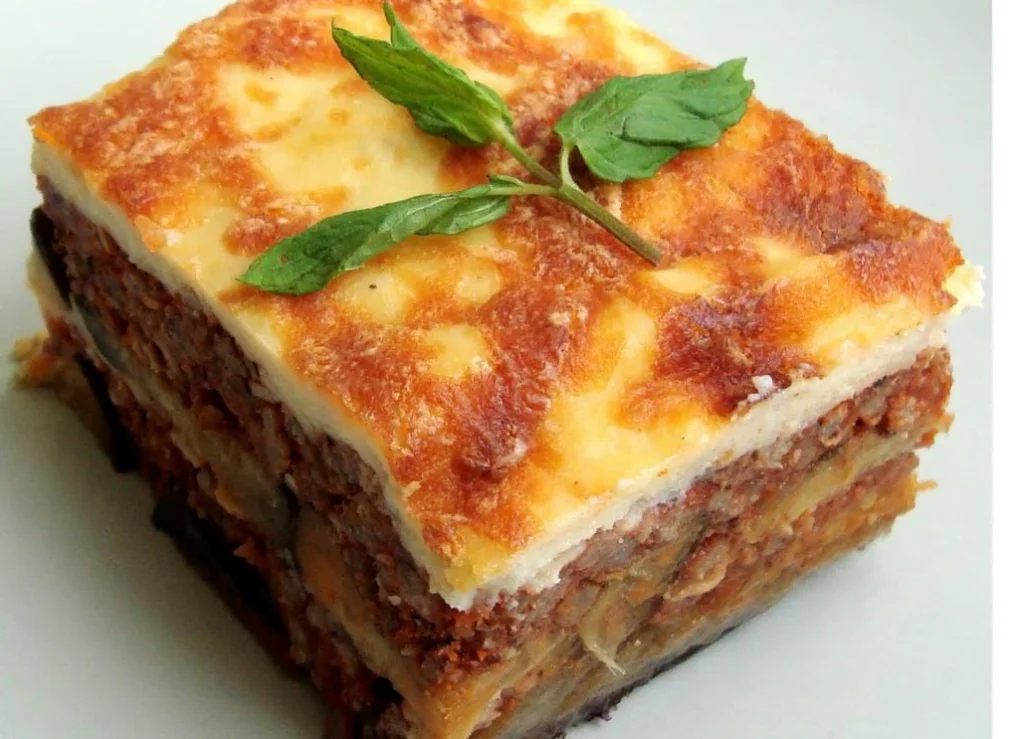
Moussaka is a cherished dish in Cyprus, with a rich history and a delicious blend of flavors. Here’s a comprehensive breakdown:
Cypriot Cuisine – The History of Moussaka
Most historians believe that Moussaka has Arabic origins, though Greek and Turkish cuisines have influenced the modern form.
Over the years, moussaka has become one of the most iconic dishes in the Eastern Mediterranean region, with each country adding its own twist to the traditional recipe.
In Cyprus, the dish has been embraced with particular additions and twists that make the Cypriot version unique. For instance, some Cypriot versions include ingredients like halloumi cheese.
Ingredients
Vegetables
- 2-3 large aubergines (eggplants), thinly sliced
- 2-3 large potatoes, thinly sliced (optional in some versions)
Meat Filling
- 500g minced lamb or beef
- 1 large onion, finely chopped
- 2-3 cloves garlic, minced
- 1 can (400g) chopped tomatoes
- 2 tbsp tomato paste
- 1 tsp cinnamon
- 1 tsp oregano
- Salt and pepper to taste
- A splash of red wine (optional)
Béchamel Sauce
- 75g butter
- 75g flour
- 750ml milk
- 100g grated halloumi or kefalotyri cheese (or a mix of both)
- 1 egg, beaten
- Pinch of nutmeg
- Salt and pepper to taste
Topping
- Grated halloumi or kefalotyri cheese
- Breadcrumbs (optional for added crunch)
Preparation Method
Preparation of Vegetables
- Salt the aubergine slices and let them sit for 30 minutes to draw out moisture, then rinse and pat dry.
- In a frying pan, lightly fry the aubergine and potato slices in olive oil until slightly golden. Set aside.
Meat Filling
- In a pan, sauté onions and garlic in a little oil until translucent.
- Add the minced meat and cook until browned.
- Add the chopped tomatoes, tomato paste, spices, and wine (if using). Let it simmer for 20-30 minutes until the sauce thickens. Season with salt and pepper.
Béchamel Sauce
- In a pot, melt the butter and whisk in the flour until it forms a roux.
- Gradually add the milk, constantly whisking to avoid lumps. Bring to a simmer.
- Once thickened, remove from heat and stir in the cheese, beaten egg, nutmeg, salt, and pepper.
Layering
- In a large baking dish, start with a layer of fried potatoes (if using).
- Follow with a layer of aubergine slices.
- Spread the meat mixture over the aubergines.
- Add another layer of aubergines.
- Pour the béchamel sauce over the top, ensuring it covers the entire surface.
- Sprinkle with additional grated cheese and breadcrumbs, if using.
Baking
- Preheat the oven to 180°C (350°F).
- Bake the moussaka for about 45 minutes or until the top is golden and bubbly.
Presentation
Dish
Use a rectangular or square baking dish for the classic moussaka look.
Serving
Once baked, let it rest for 10-15 minutes before cutting into squares or rectangles. This helps the layers to set, making it easier to serve.
Garnish
You can garnish with a sprinkle of fresh chopped parsley for color and freshness.
Beverage Pairing
- Wine: A medium-bodied red wine, such as a Cypriot Maratheftiko or a Greek Agiorgitiko, complements the rich flavors of the moussaka.
- Non-Alcoholic: A chilled sparkling water with a slice of lemon or a minty iced tea can also be refreshing with this dish.
Enjoy your Cypriot Moussaka!
Cypriot Cuisine Kleftiko

Kleftiko is a quintessential Cypriot dish that boasts a deep historical and cultural significance.
The word “Kleftiko” translates to “in the style of the klephts.” Klephts were bandits or highwaymen in the mountains of Greece and Cyprus during Ottoman rule.
Due to their lifestyle, the klephts developed a method of cooking lamb buried underground to avoid detection from the smoke. The dish is traditionally cooked in sealed clay ovens for several hours, ensuring tender meat.
Kleftiko has become a renowned dish in Cyprus and represents the island’s rich culinary traditions.
Cypriot Cuisine Kleftiko Ingredients
Meat & Main Ingredients
- 1.5kg – 2kg leg of lamb or lamb shoulder, bone-in, cut into large chunks
- 6-8 cloves of garlic, sliced
- 2-3 bay leaves
- Fresh rosemary sprigs
Marinade
- Juice of 2 lemons
- 3-4 tbsp olive oil
- 2 tsp dried oregano
- Salt and freshly ground pepper to taste
Potatoes
- 4-5 large potatoes, peeled and cut into wedges
- Olive oil
- Salt and pepper to taste
Preparation Method
Marinating
- In a large bowl, combine lemon juice, olive oil, oregano, salt, and pepper.
- Add the lamb pieces to the marinade, ensuring they are well coated. Refrigerate and let it marinate for at least 4 hours, preferably overnight.
Preparing the Lamb
- Make small incisions in the lamb pieces and insert garlic slices.
- Place bay leaves and rosemary sprigs among the lamb pieces.
Potatoes
- Toss potato wedges in olive oil, salt, and pepper.
Cooking
Traditionally, kleftiko is cooked in a clay oven sealed with dough to lock in moisture and flavor. If you don’t have access to such an oven, you can replicate this method:
- Preheat your oven to 150°C (300°F).
- Place the marinated lamb pieces in a deep roasting pan.
- Add the seasoned potato wedges around the lamb.
- Cover the roasting pan tightly with multiple layers of aluminum foil to seal in all the juices and flavors.
- Cook for at least 4 hours, until the meat is incredibly tender and can be easily pulled apart.
Presentation
Dish
A deep serving dish or platter is ideal to showcase the tender lamb and potatoes.
Serving
Once cooked, the lamb should be so tender it can be easily pulled apart. Serve with the roasted potatoes.
Garnish
Garnish with fresh rosemary sprigs and a drizzle of lemon juice, if desired.
Beverage Pairing
- Wine: A robust red wine, such as a Cypriot Commandaria or a Greek Xinomavro, will pair wonderfully with the hearty flavors of kleftiko.
- Non-Alcoholic: For a non-alcoholic pairing, consider a chilled lemon and mint sparkling water to complement the richness of the lamb.
Enjoy your Cypriot Kleftiko!
Cypriot Cuisine – Souvlaki

Souvlaki is a cherished dish not only in Cyprus but throughout the entire Eastern Mediterranean region. Here’s an in-depth look into Cypriot Souvlaki:
The term “Souvlaki” is derived from the Greek word “souvla,” which means “spit” or “skewer.”
Versions of grilled skewered meat can be traced back to ancient Greece. Historical references, including in works by Homer, mention pieces of meat being grilled on spits.
While the dish has widespread popularity in Greece, Cyprus has its unique take on it, incorporating local flavors and ingredients.
Unlike Greek souvlaki which is often made with pork, Cypriot souvlaki commonly uses lamb or chicken.
Cypriot Cuisine Souvlaki Ingredients
Meat
- 600g of lamb or chicken, cut into 2cm cubes
Marinade
- 3-4 tbsp olive oil
- Juice of 2 lemons
- 2-3 cloves garlic, minced
- 1 tsp dried oregano
- Salt and freshly ground pepper to taste
To Serve
- Pita bread
- Tzatziki sauce
- Sliced tomatoes
- Sliced cucumbers
- Chopped lettuce
- Sliced onions
- Fresh lemon wedges
Preparation Method
Marinating
- In a large bowl, combine olive oil, lemon juice, garlic, oregano, salt, and pepper.
- Add the cubed meat to the marinade, ensuring they are well coated. Cover and let it marinate in the refrigerator for at least 2-4 hours.
Skewering
- Thread the marinated meat cubes onto metal or wooden skewers. If using wooden skewers, soak them in water for about 30 minutes before using to prevent burning.
Grilling
- Preheat a grill or barbecue to medium-high heat.
- Place the skewers on the grill and cook for 10-12 minutes, turning occasionally, until the meat is cooked through and has a slight char on the outside.
Serving
- Warm the pita bread on the grill for a minute or two.
- Remove the meat from the skewers and place it inside the pita bread.
- Add the desired toppings like tzatziki sauce, tomatoes, cucumbers, lettuce, and onions.
- Fold the pita bread over the fillings to create a wrap.
Presentation
- Dish: A plate or a platter can be used to serve the souvlaki.
- Layout: Place the souvlaki wrap on the plate, accompanied by fresh lemon wedges and extra tzatziki on the side.
- Garnish: Garnish with a sprinkle of dried oregano or a sprig of fresh parsley for color.
Beverage Pairing
- Wine: A light red or crisp white wine, such as a Cypriot Xinisteri (white) or a Greek Assyrtiko, pairs well with the grilled flavors of souvlaki.
- Beer: A chilled local Cypriot or Greek lager complements the dish perfectly.
- Non-Alcoholic: A cold minted lemonade or a traditional Greek/Cypriot ayran (yogurt-based drink) will also pair nicely.
Enjoy you Cypriot Souvlaki!
Cypriot Cuisine – Halloumi

Halloumi is one of Cyprus’ most famous and cherished culinary exports. Let’s delve into the world of Cypriot Halloumi.
Halloumi cheese has been produced in Cyprus for centuries, with some records suggesting it dates back to the Byzantine period (AD 395 – 1191).
Halloumi’s unique ability to retain its shape when heated (without melting away) sets it apart from many other cheeses.
Halloumi gained a “Protected Designation of Origin” (PDO) status from the European Union in 2020, recognizing its deep roots in Cypriot culture and traditions.
In Cyprus, the cheese has historically been made in households across the country, making it an integral part of the island’s culinary identity.
Cypriot Cuisine Halloumi Ingredients
- Halloumi Cheese Slices: Typically, you would buy halloumi as a block and then slice it. Look for authentic Cypriot halloumi made from a mixture of goat’s and sheep’s milk (sometimes with a bit of cow’s milk).
- Olive Oil: For frying or grilling.
- Optional Ingredients for Serving:
- Fresh mint leaves
- Watermelon slices
- Lemon or lime wedges
- Drizzle of honey or a sprinkle of za’atar
Preparation Method
- Slicing: If you have a block of halloumi, cut it into slices about 1cm thick.
- Cooking:
- Grilling: Preheat a grill to medium-high. Brush the halloumi slices lightly with olive oil and grill for 2-3 minutes on each side, until they have nice grill marks and are slightly golden.
- Frying: Heat a bit of olive oil in a frying pan over medium heat. Add the halloumi slices and fry for 2-3 minutes on each side, until golden brown.
- Serving: Serve the halloumi immediately while it’s still warm and a bit soft inside.
Presentation
- Dish: Use a flat serving platter or plate.
- Arrangement: Lay out the grilled or fried halloumi slices.
- Garnish: Sprinkle with fresh mint leaves and accompany with slices of watermelon, a traditional Cypriot pairing. For a more modern twist, drizzle with honey or sprinkle with za’atar, and serve with lemon or lime wedges on the side.
Beverage Pairing
- Wine: A crisp Cypriot white wine, such as Xinisteri, complements the saltiness of the halloumi beautifully.
- Beer: A light, refreshing lager or pilsner can also be a great accompaniment.
- Non-Alcoholic: A cool minty lemonade or a fresh cucumber water can balance out the richness of the cheese.
Enjoy your Cypriot Halloumi experience!
Cypriot Cuisine – Sheftalia
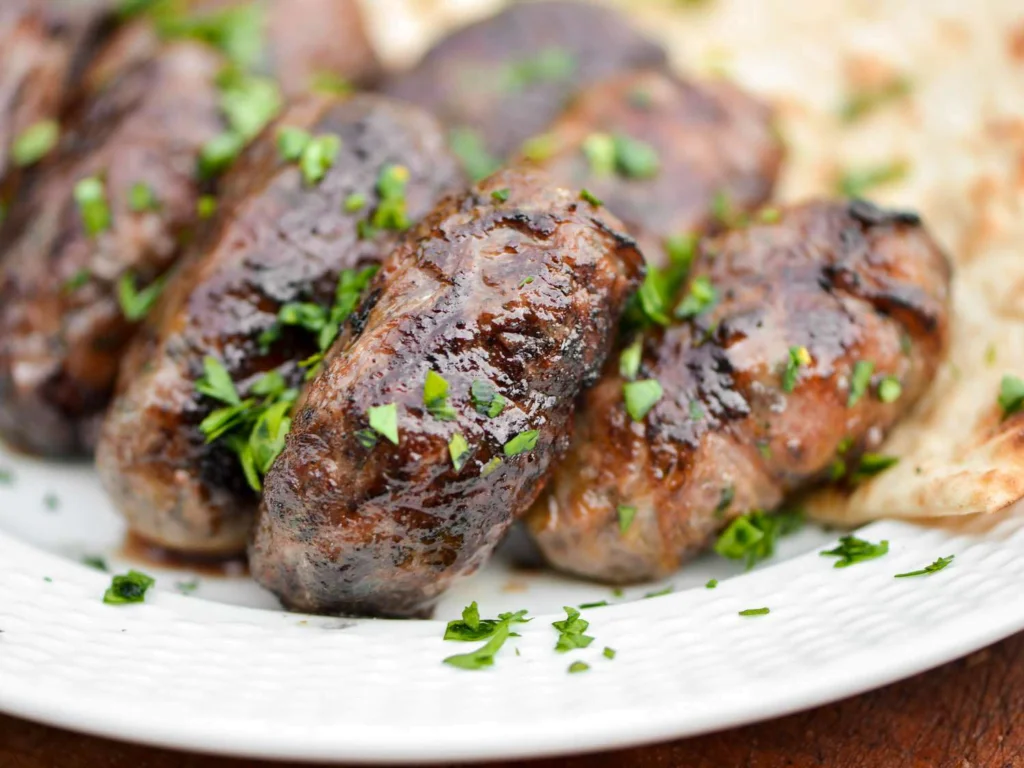
Sheftalia is a delicious and traditional Cypriot sausage-like dish. Let’s explore its origins and how to make it.
Sheftalia is deeply rooted in Cypriot culinary traditions, representing the island’s love for grilling and the efficient use of meat.
The dish uses caul fat (also known as lace fat) to wrap seasoned meat, which ensures moisture and flavor retention during grilling.
Often enjoyed in social settings, Sheftalia is commonly found at Cypriot barbecues and is a beloved component of mixed grill platters.
Cypriot Cuisine Sheftalia Ingredients
- Meat Filling:
- 500g minced pork (or a mix of pork and lamb)
- 1 medium onion, finely chopped
- 1/4 cup fresh parsley, finely chopped
- 2-3 slices of stale bread, soaked in water and squeezed
- 2 cloves garlic, minced
- 1 tsp ground cinnamon
- Salt and freshly ground pepper to taste
- Wrapper:
- Caul fat (enough to wrap the meat mixture)
- To Serve (optional):
- Pita bread
- Sliced tomatoes
- Sliced cucumbers
- Chopped lettuce
- Sliced onions
- Tzatziki or tahini sauce
Preparation Method
- Filling:
- In a large bowl, combine the minced pork, chopped onion, parsley, soaked bread, garlic, cinnamon, salt, and pepper. Mix well until all ingredients are evenly distributed.
- Shaping:
- Take a small amount of the meat mixture (about the size of a walnut) and shape it into a small sausage or oval shape.
- Wrapping:
- Clean the caul fat and cut it into square or rectangular pieces.
- Place each shaped meat portion onto a piece of caul fat and wrap it, tucking in the edges. Continue until all the meat is wrapped.
- Grilling:
- Preheat a grill or barbecue to medium-high heat.
- Place the sheftalia on the grill and cook for about 10-12 minutes, turning occasionally, until they are golden brown and cooked through.
- Serving:
- Warm the pita bread on the grill for a minute or two.
- Place a couple of sheftalia inside the pita bread, add your desired toppings, and drizzle with tzatziki or tahini sauce.
Presentation
- Dish: Use a flat serving platter or individual plates.
- Arrangement: Lay out the grilled sheftalia, preferably with some char marks visible.
- Garnish: Serve alongside freshly sliced vegetables, warm pita bread, and a generous dollop of sauce.
Beverage Pairing
- Wine: A light to medium-bodied Cypriot red wine, like Maratheftiko, can nicely balance the flavors of sheftalia.
- Beer: A refreshing local lager complements the grilled, savory notes of the dish.
- Non-Alcoholic: A chilled ayran (a yogurt-based drink) or lemon and mint sparkling water can be very refreshing with sheftalia.
Enjoy your Cypriot Sheftalia experience!
Cypriot Cuisine – Dolmades
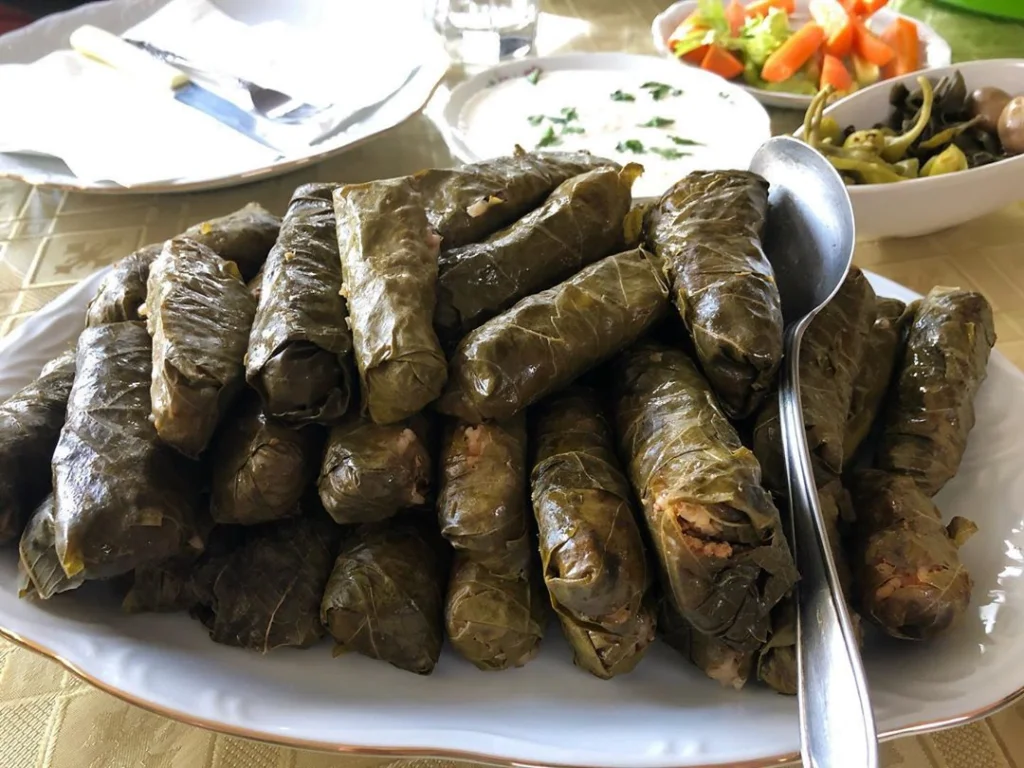
Dolmades are a classic meze dish that are as popular today as they were centuries ago. Stuffed grape leaves with a savory rice and herb filling, these bitesize treats are perfect for sharing with friends and family.
Dolmades, also known as “stuffed vine leaves” or “dolmadakia” in some regions, are a staple in various Mediterranean and Middle Eastern cuisines. Let’s delve into the Cypriot version of Dolmades.
The idea of stuffing vegetables has ancient origins and is documented in various cultures. The vine leaves version, known as dolmades, has a rich history in the Mediterranean basin.
Over centuries, through conquests, trade, and migrations, the art of making stuffed vine leaves spread across different cultures, each adopting its own variation.
The Cypriot version of dolmades often includes minced meat (usually pork in Cyprus) combined with rice and various herbs, making it distinct from the vegetarian versions prevalent in some other cultures.
Cypriot Cuisine Dolmades Ingredients
- Vine Leaves:
- About 40-50 fresh or preserved vine leaves (if preserved, they should be rinsed well to remove excess salt)
- Filling:
- 250g minced pork (or a mix of pork and beef)
- 1 cup short-grain rice, rinsed and drained
- 1 large onion, finely chopped
- 2-3 cloves garlic, minced
- 1/4 cup fresh parsley, finely chopped
- 1/4 cup fresh mint, finely chopped
- 2 tbsp olive oil
- 1 tsp ground cinnamon
- Salt and freshly ground pepper to taste
- Juice of 1 lemon
- Cooking Liquid:
- 2 cups chicken or vegetable broth
- Juice of 1-2 lemons
Preparation Method
- Preparation of Vine Leaves:
- If using fresh vine leaves: Blanch them in boiling water for 2-3 minutes, then plunge into cold water. Drain and set aside.
- If using preserved vine leaves: Rinse thoroughly to remove salt and brine. Soak them in warm water for 20-30 minutes, then drain.
- Filling:
- In a bowl, combine the minced pork, rice, onion, garlic, parsley, mint, olive oil, cinnamon, salt, pepper, and lemon juice. Mix well.
- Stuffing:
- Lay a vine leaf flat on a work surface with the shiny side down.
- Place a small amount of filling (about a teaspoon) in the center of the leaf.
- Fold the bottom part of the leaf over the filling, then fold in the sides and roll it up to form a small, tight cylindrical package. Repeat with the remaining leaves and filling.
- Cooking:
- Arrange the rolled dolmades, seam side down, in a large, wide pot. They should be packed closely together to prevent them from opening during cooking.
- Pour the chicken or vegetable broth and lemon juice over the dolmades.
- Place a plate upside down on top of the dolmades to keep them in place during cooking.
- Bring the liquid to a simmer, cover the pot, and let them cook for about 45-50 minutes, until the rice and meat are fully cooked.
- Serving:
- Let the dolmades cool slightly in the pot, then transfer them to a serving dish.
Presentation
- Dish: Serve on a decorative platter or shallow bowl.
- Arrangement: Dolmades can be arranged in concentric circles or in neat rows.
- Garnish: Drizzle with a bit of olive oil and sprinkle with freshly chopped parsley or mint. Optionally, serve with lemon wedges or a yogurt-based sauce on the side.
Beverage Pairing
- Wine: A crisp Cypriot white wine, such as Xinisteri, complements the herbal and citrus flavors of the dolmades.
- Beer: A light lager can refresh the palate when eating dolmades.
- Non-Alcoholic: A cold minted lemonade or rose water-infused drink would pair nicely with the dish.
Enjoy your Cypriot Dolmades experience!
Cypriot Cuisine – Keftedes
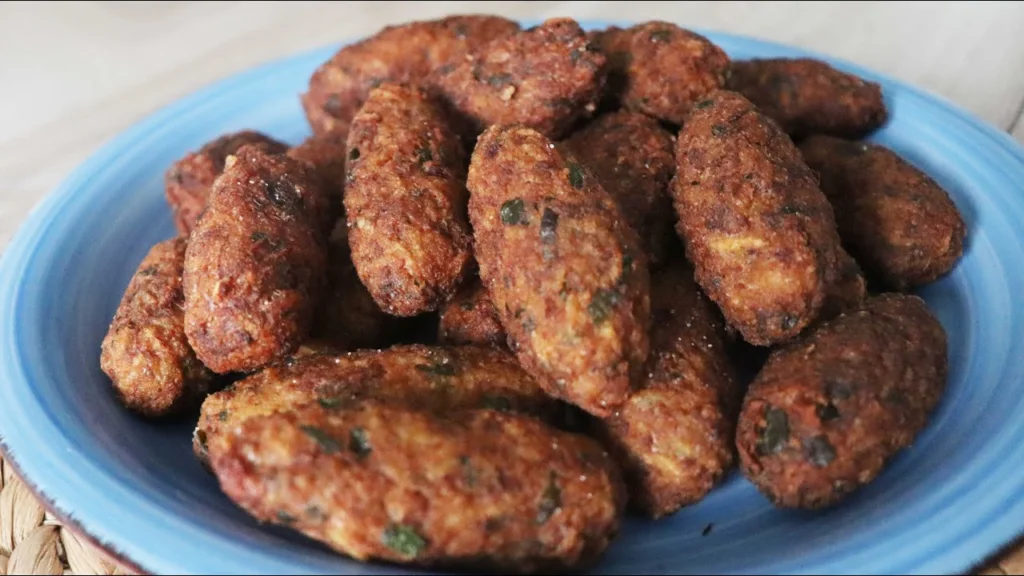
Keftedes are another meze staple and a favorite among meat lovers. These juicy and flavorful meatballs are made with ground beef, onion, herbs, and spices, and are often served with tzatziki sauce.
Keftedes are spiced meatballs and are a popular dish not only in Cyprus but also throughout the Mediterranean region, with each culture adding its unique touch. Let’s focus on the Cypriot version of Keftedes.
The concept of minced meat shaped into balls or patties and then cooked is ancient and has manifested in many cultures.
In Cyprus, Keftedes are traditionally made with pork or a mix of pork and beef, seasoned with herbs like mint and sometimes spiced with cinnamon. They can be found in many Cypriot households and restaurants.
Keftedes are often served at family gatherings, making them a cherished comfort food for many Cypriots.
Cypriot Cuisine Keftedes Ingredients
- 500g minced pork (or a mix of pork and beef)
- 1 large onion, finely grated or minced
- 2-3 slices of stale bread, soaked in water and squeezed
- 1 egg, beaten
- 1/4 cup fresh parsley, finely chopped
- 1/4 cup fresh mint, finely chopped
- 1 tsp ground cinnamon
- Salt and freshly ground pepper to taste
- Olive oil or vegetable oil, for frying
Preparation Method
- Mixing Ingredients:
- In a large mixing bowl, combine the minced meat, grated onion, soaked bread, beaten egg, parsley, mint, cinnamon, salt, and pepper. Mix well until all ingredients are well combined.
- Forming Keftedes:
- Take a portion of the mixture and shape it into a small ball or slightly flattened patty. Repeat until all the mixture is used up.
- Frying:
- Heat the oil in a large frying pan over medium-high heat. Once hot, add the keftedes in batches, ensuring not to overcrowd the pan.
- Fry until they are golden brown on all sides and cooked through, usually about 4-6 minutes per side.
- Once cooked, transfer them to a plate lined with paper towels to drain any excess oil.
Presentation
- Dish: Keftedes can be served on a large platter or in a serving bowl.
- Arrangement: Pile the keftedes neatly, showing off their golden-brown crust.
- Garnish: Garnish with some fresh mint or parsley leaves. They can be served with lemon wedges, allowing diners to squeeze fresh lemon juice over them.
Beverage Pairing
- Wine: A medium-bodied Cypriot red wine, such as Maratheftiko or a local rosé, pairs well with the rich flavors of keftedes.
- Beer: A Cypriot lager or pilsner can complement the savory meatballs.
- Non-Alcoholic: A chilled minty lemonade or a Cypriot sour cherry drink would offer a refreshing counterpoint to the dish.
Enjoy your Cypriot Keftedes experience!
Cypriot Cuisine – Loukoumades

For a sweet finish to your Cypriot feast, try loukoumades, a popular dessert that’s similar to doughnuts but softer and soaked in honey syrup. These bite-sized treats are easy to make and guaranteed to satisfy your sweet tooth.
Loukoumades are delicious deep-fried dough balls that are drenched in syrup, honey, or other sweet toppings. They are popular in many parts of the Mediterranean and the Middle East, with each region offering its own special touch.
The history of Loukoumades traces back to ancient times. In ancient Greece, they were known as “honey tokens” and were awarded as prizes to winners of the Olympic games.
In Cyprus, as in Greece, Loukoumades are a beloved dessert, especially during festivals and special occasions. They’re often flavored with local honey and sometimes dusted with cinnamon or garnished with crushed nuts.
Over time, Loukoumades have become a treat synonymous with celebrations and are commonly served at fairs, festivals, and family gatherings.
Cypriot Cuisine Loukoumades Ingredients
- Dough:
- 500ml warm water
- 2 tsp dry yeast
- 1 tbsp sugar
- 500g all-purpose flour
- 1/2 tsp salt
- Vegetable oil, for frying
- Syrup:
- 1 cup sugar
- 1 cup water
- 1 tsp lemon juice
- Optional: a cinnamon stick or a couple of cloves for added flavor
- Toppings:
- Honey (preferably Cypriot)
- Ground cinnamon
- Crushed walnuts or almonds
Preparation Method
- Dough Preparation:
- In a large bowl, combine the warm water, sugar, and dry yeast. Let it sit for about 10 minutes until it becomes frothy.
- Gradually add the flour and salt to the yeast mixture, stirring continuously until a smooth batter is formed. The consistency should be like a thick pancake batter.
- Cover the bowl with a cloth and let it rise in a warm place for about 1-2 hours or until it has doubled in size.
- Making the Syrup:
- In a saucepan, combine sugar, water, and lemon juice (and optionally the cinnamon or cloves). Bring to a boil and then simmer for about 10 minutes until slightly thickened. Remove from heat and allow to cool.
- Frying:
- Heat the vegetable oil in a deep frying pan or pot over medium-high heat.
- Once hot, use a spoon or small ice cream scoop to drop balls of the dough into the hot oil.
- Fry the Loukoumades until they are golden brown on all sides, turning them occasionally for even browning.
- Remove them using a slotted spoon and drain on paper towels.
- Serving:
- While still warm, drizzle the Loukoumades with the cooled syrup or honey.
- Sprinkle with ground cinnamon and/or crushed nuts.
Presentation
- Dish: Serve Loukoumades on a shallow plate or wide bowl.
- Arrangement: They can be piled in a mound or arranged in a circle.
- Garnish: The shimmering syrup or honey, along with a generous dusting of cinnamon and sprinkling of nuts, adds both flavor and aesthetic appeal.
Beverage Pairing
- Coffee: A traditional Cypriot coffee, which is strong and slightly bitter, can perfectly counterbalance the sweetness of Loukoumades.
- Tea: A lightly brewed herbal tea, like mountain tea or chamomile, can be a refreshing accompaniment.
- Dessert Wine: A sweet Cypriot Commandaria wine can enhance the dessert experience.
- Non-Alcoholic: A cold glass of milk or a chilled vanilla milkshake complements the warm, sweet Loukoumades.
Enjoy your Cypriot Loukoumades experience!
These are just a few examples of the famous Cypriot recipes that you can try in your own kitchen. From mezedes to desserts, Cypriot cuisine offers a world of flavors that you won’t want to miss. So why not experiment with some Cyprus traditional recipes and add a touch of Mediterranean magic to your meals?
Conclusion
I hope you enjoyed our Cypriot culinary journey together! Cyprus is truly a land of flavors and aromas that will delight your senses. From traditional dishes to famous recipes, the food of Cyprus has something for everyone.
Remember, embracing the Cypriot culinary spirit is all about using fresh, wholesome ingredients and traditional cooking techniques. Whether it’s grilling meat on a charcoal barbecue or preparing a refreshing tzatziki dip, there’s a wealth of Cypriot recipes waiting for you to explore and enjoy.
So, why not try your hand at cooking some of these authentic Cypriot dishes in your own kitchen? Invite some friends over, open a bottle of crisp white wine, and enjoy a delicious, Mediterranean-inspired feast. Trust me, your taste buds will thank you for it!
I hope you found this article informative and inspiring. Join me on my next culinary adventure as we explore another exciting cuisine from around the world. Until then, happy cooking!
FAQ’s
What are some traditional Cypriot dishes?
Some traditional Cypriot dishes include souvlaki, moussaka, tzatziki, and halloumi cheese.
What are mezedes?
Mezedes are small plates meant for sharing and socializing in Cypriot cuisine. They include dishes like dolmades, keftedes, and loukoumades.
How can I recreate authentic Cypriot flavors in my own kitchen?
To recreate authentic Cypriot flavors, use traditional ingredients and cooking methods. Choose fresh produce, local herbs and spices, and follow traditional recipes for the best results.
What is the culinary heritage of Cyprus?
The culinary heritage of Cyprus is a blend of Greek, Turkish, Middle Eastern, and Mediterranean influences. It reflects the unique history and cultural diversity of the island.
What should I expect from Cypriot cuisine?
You can expect a tantalizing blend of tastes and aromas in Cypriot cuisine. From savory souvlaki to refreshing tzatziki, Cypriot dishes offer a range of flavors that will satisfy any palate.
How can I impress my friends and family with Cypriot dishes?
To impress your loved ones with Cypriot dishes, follow traditional recipes, use authentic ingredients, and master the cooking techniques. Share the rich flavors and cultural heritage of Cyprus with your culinary creations.

